-
Homer Spit to Veldovia
We boarded the Rainbow Connection at the Homer Spit boatyard, a short walk from our campground. Luckily, there were two, openings when we make this last minute booking this morning

The sailing to Seldovia took 2.5 hours and scenery along the way was gorgeous.

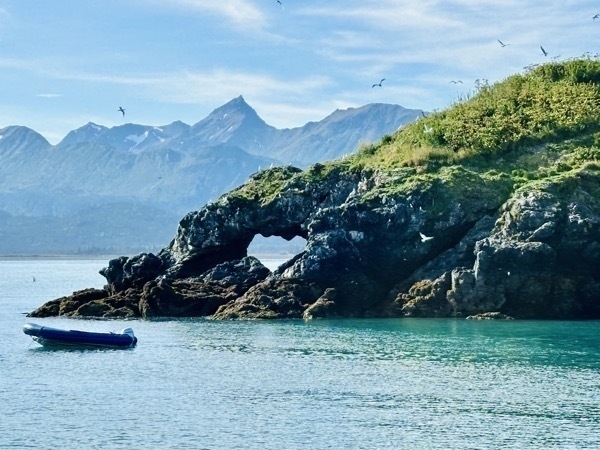
We saw puffins, humpback whales, ostereagles, bald eagles, rafts of sea otters and several bird rookeries.

Puffin
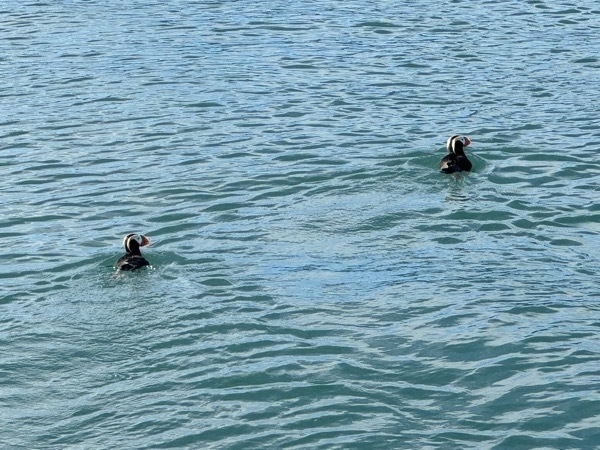
American Bald Eagle
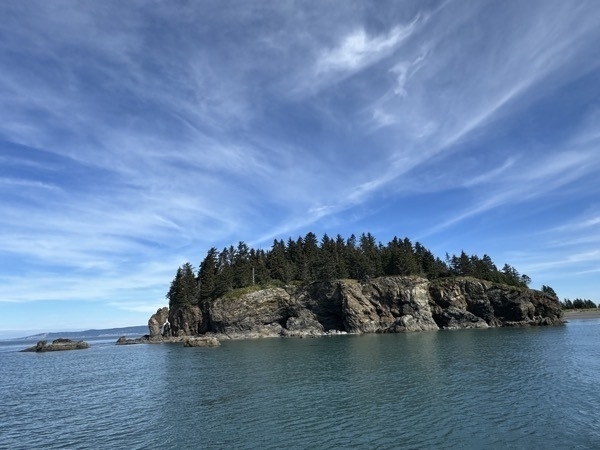
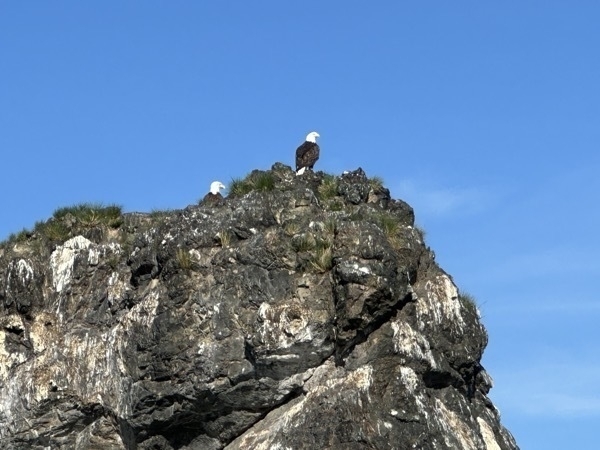
Bald Eagle
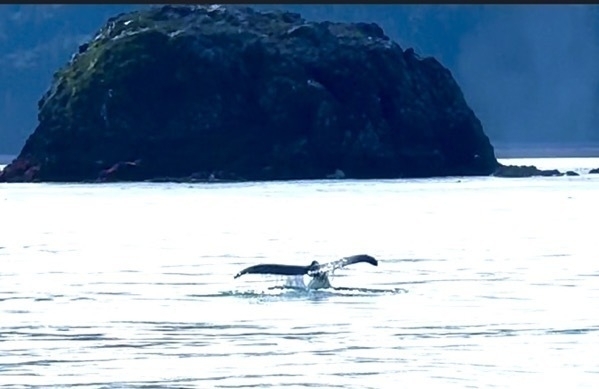
Humpback Whale
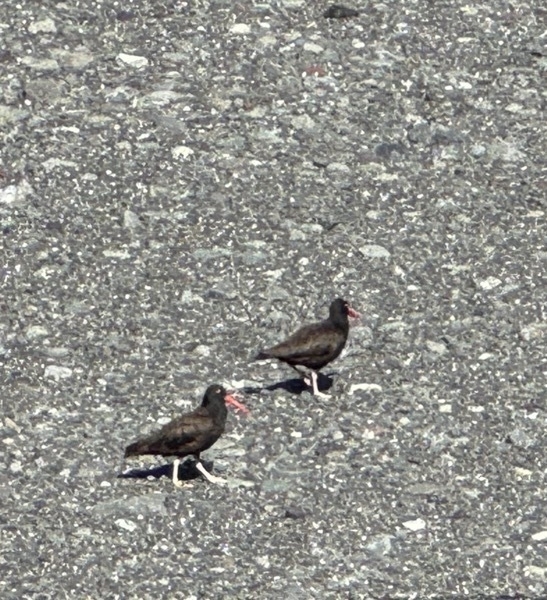
Black Osytereaters
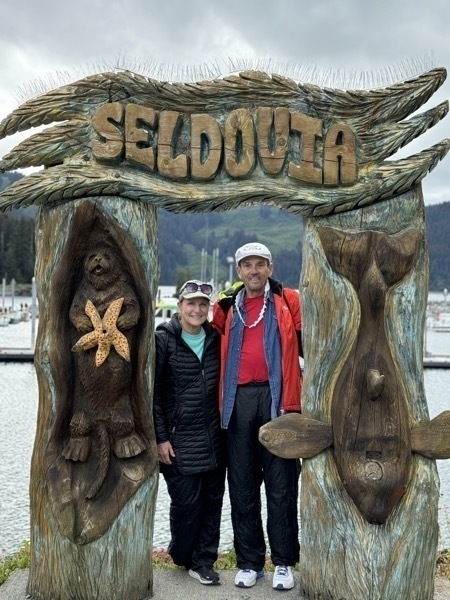 ]
]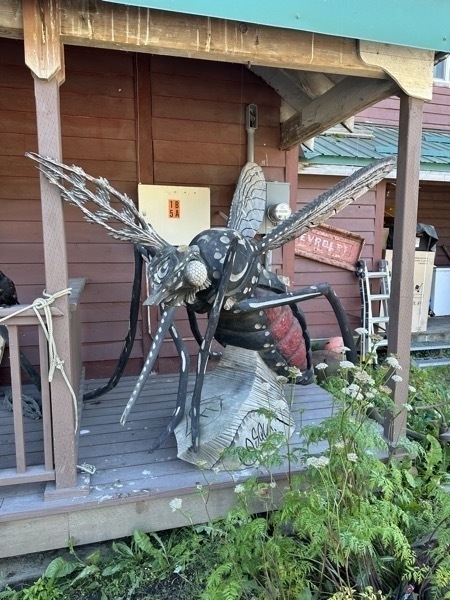
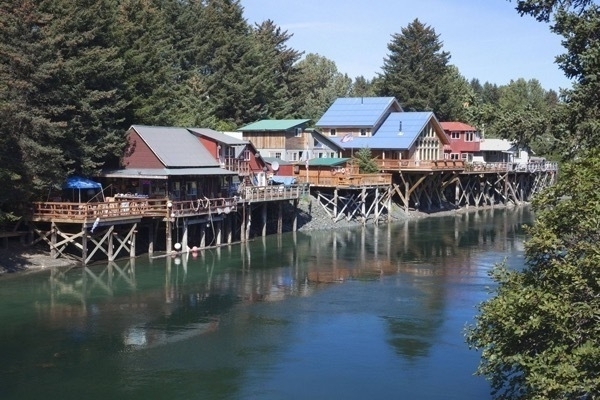
THE ORIGINAL SETTLEMENT IN SELDOVIA was built along the waterfront. Access to homes and businesses was by way of the beach but only at low tide. In the late 1920s and early '30s a community effort was organized to build a wooden boardwalk, which made it possible to walk from one end of town to the other no matter what the stage of the tide.Seldovia came to be known as a "Boardwalk Town."
FRIDAY, MARCH 27, 1964, 5:36 PM, the Good Friday Earthquake exploded with titanic force. This massive earthquake, the strongest ever recorded in North America. changed the destiny of Seldovia forever.
It was not long before people realized there was a serious problem .. the land had dropped 4 feet. At high tides. seawater flooded over the boardwalk and poured into buildings along the waterfront. In the autumn of 1964, Severe storms and the highest seasonal tides pounded the boardwalk. The watefront was doomed and the town had to be rebuilt.
Waterfront buildings were demolished, seawalls were constructed and Caps Hill in the middle of town was leveled. It took two years before the town got on its feet again. However, the town would never again be the center of commercial fishing in Kachemak Bay. With the exception of the Wakefield Cannery, other canneries never rebuilt in Seldovia and a new road connecting Homer to Anchorage made Homer the new hub of the Kachemak Bay’s fishing fleet
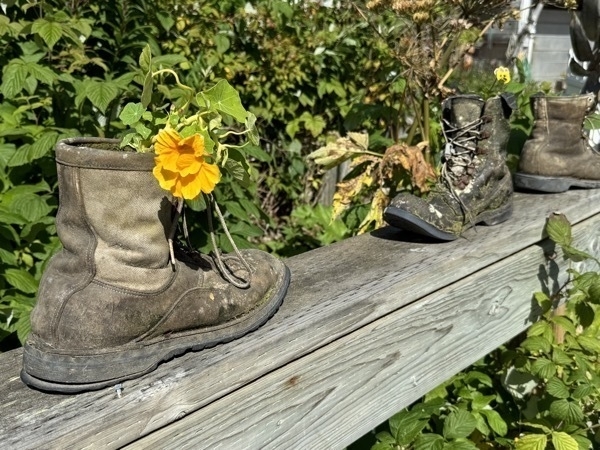
St. Nicholas Russian Orthodox Church
Saint Nicholas is known to keep close watch on Seldovia’s fishermen and sea farers—bringing them prosperity, peace, and safety. The church is one of the first things the fishermen see as they return home, and one of the last landmarks to fade from sight as they head out to sea.
The church was built in 1891 under the leadership of traveling Orthodox Priests who paddled kayaks from as far away as the Aleutian Islands and Kodiak. They traveled from village to village doing their best to make disciples of the indigenous poeple in Cook Inlet.
The chapel is still in use today whenever a Priest or Bishop is requested to visit, usually on Russian Orthodox holidays, weddings or funerals.
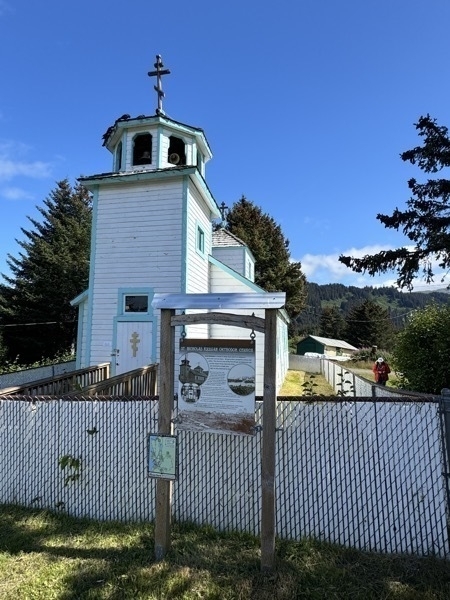
Back on the Homer Spit
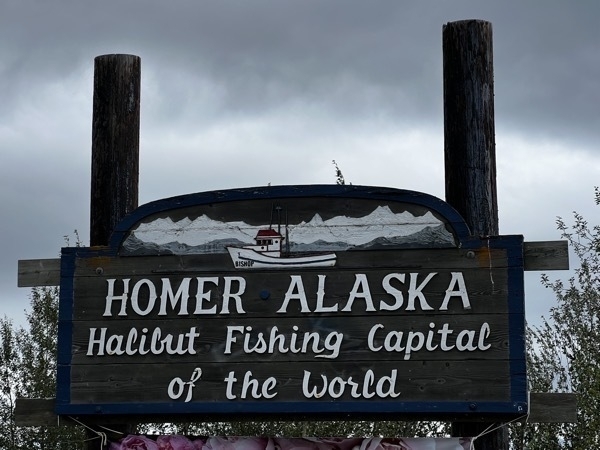
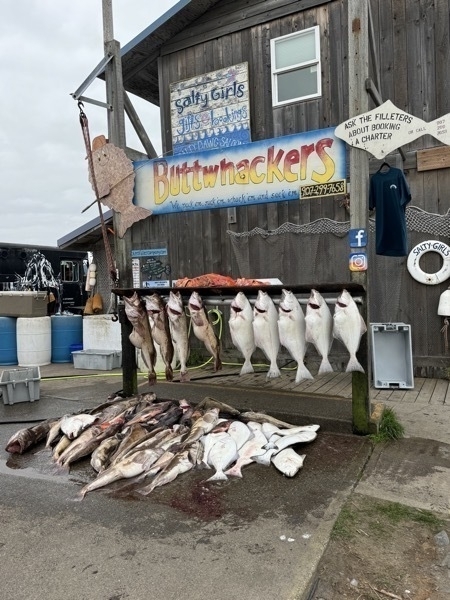
Someone’s partial catch of the day!
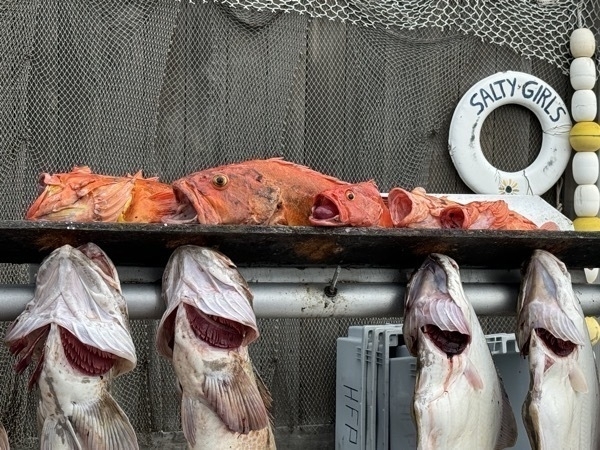
Locked out!
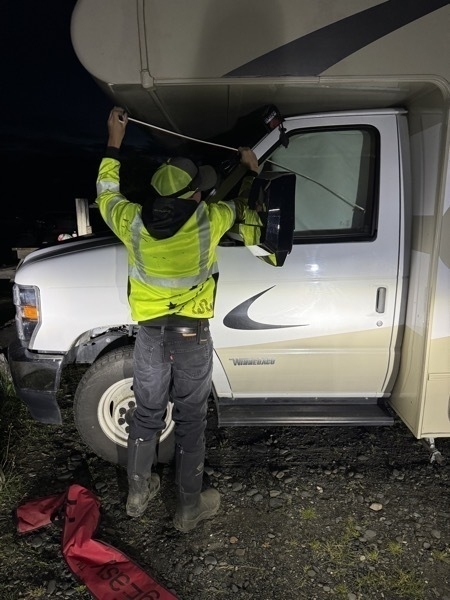
We walked out of the camper at 11:00 to stand on the beach and the door locked on us. So there we were outside of the camper with no way of getting back in. We finally found a locksmith who arrived around midnight to open the door for us.
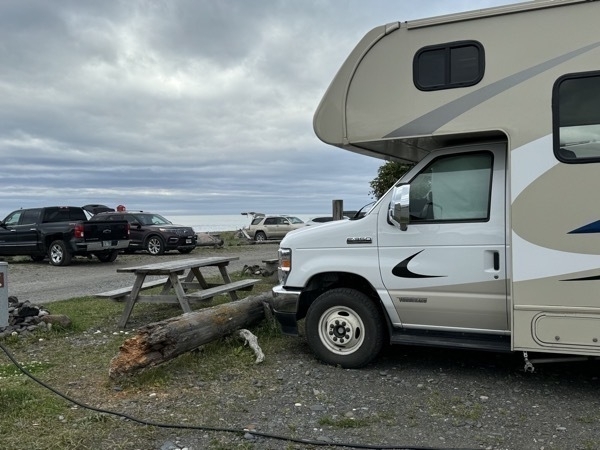
We stayed at the Homer Spit Campground for $64.71. It is located right on the water and afforded some pretty views.
-
STUCK ON CATARACT GLACIER
STUCK ON A GLACIER
Before we left Lake Charles we scheduled a helicopter ride from Palmer, AK to the Cataract Glacier for a dog sledding experience with Great Alaska Helicopter Tours.
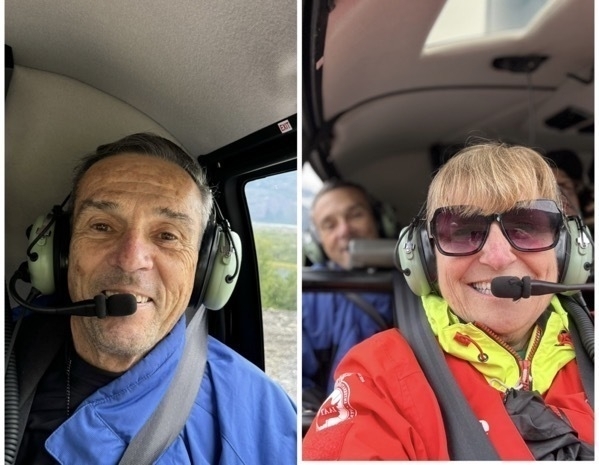
The helicopter ride crossed the Matanuska River, followed the Knit River, the Chugach Mountain Range, and then traveled across Lake George before finally arriving the Cataract Glacier.
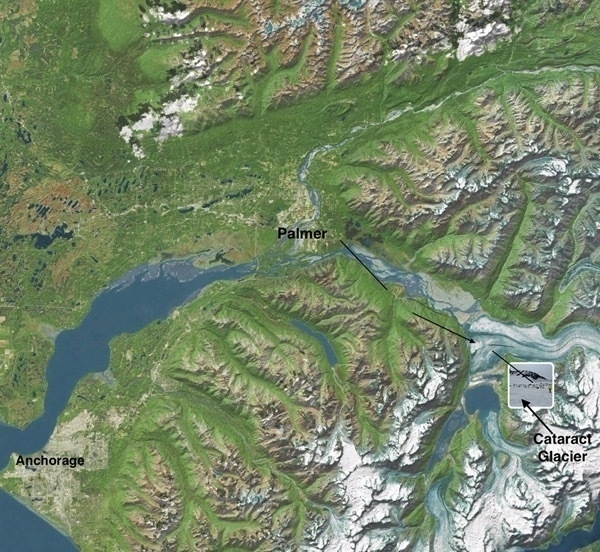
This is the satellite view of our helicopter ride to the glacier.

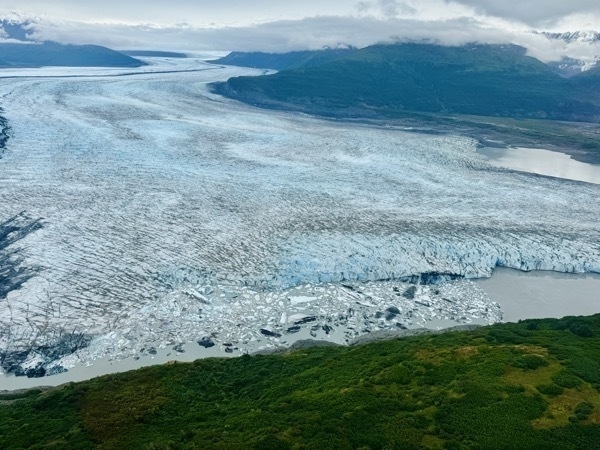



Cataract Glacier
There were about 60 dogs that live up on this glacier for summer. They belong to Dallas Seavey who has won the Iditarod 6 times. The dog handlers work for him.

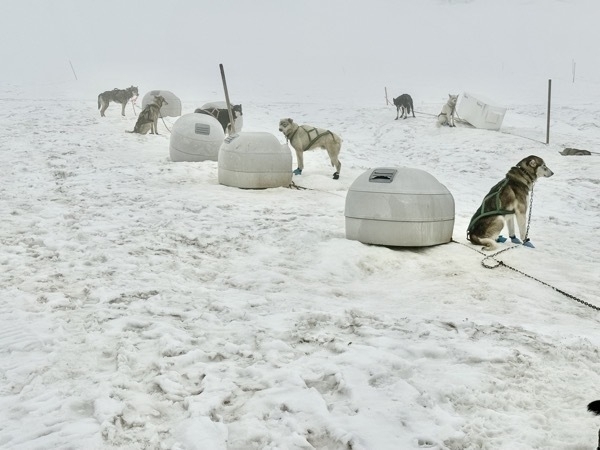
The dogs were so excited about getting hooked up to pull the sled and were all barking. The mushers put shoes on each dog’s feet and hooked them to the sled rope.
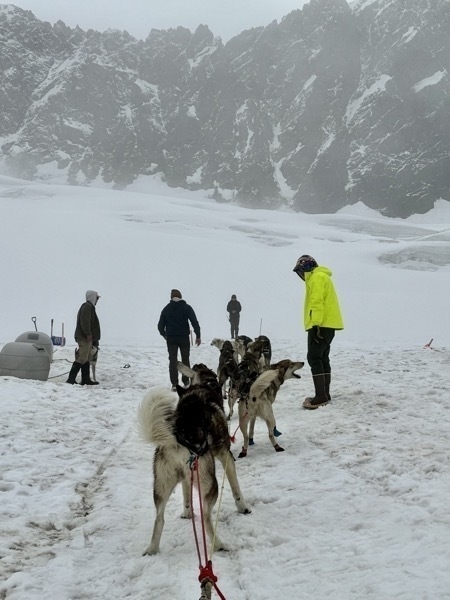
…and off we went. The back dog was a slightly different breed than the others and didn’t need shoes on his feet. Some of these very dogs were part of the team that won the Iditarod.
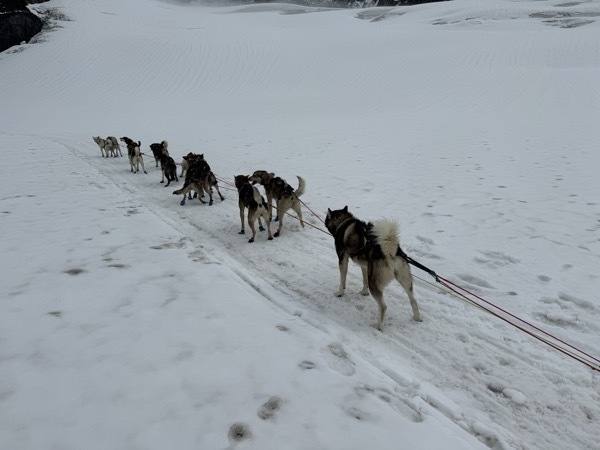
Both Tom and I had our chance to “drive” the dogsled on the two mile ride.
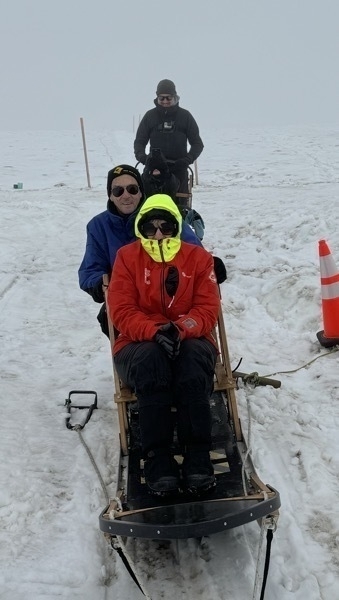

After the ride with the dogs, we were able to meet and pet all the dogs and play with the three 13 week old puppies. That was all so much fun !!!! The dog sledding was a great experienc


Interesting side note about the Iditarod:
From the Alaska Public Media. "Top 2024 Iditarod Trail Sled Dog Race contender Dallas Seavey shot and killed a moose to defend himself and his dog team early Monday about 100 miles into the 1,000-mile race, officials said.
Seavey’s team was about 14 miles past the Skwentna checkpoint when the moose “became entangled with the dogs and the musher on the trail,” according to a statement from the Iditarod. Seavey shot the moose in self-defense and notified race officials at about 1:45 a.m. Monday, the statement says.
Race rules allow Iditarod mushers to carry firearms for protection from large animals like moose, but they must stop to gut any big game animal they shoot so it can be salvaged. The rules also say that any mushers who come upon a fellow competitor in the process of gutting a game animal must stop and help, and they’re not allowed to pass until the musher who killed the animal has continued on the trail."
Then, came the unexpected.
The helicopter was unable to return to the glacier due to heavy cloud cover. We were supposed to go back at 1:30 pm. The helicopter kept trying until dark to no avail. We were now STUCK on the glacier for the night!!!! The company said that has never happened before on the Cataract Glacier.
Tom and I, along with another couple, spent the night in one of the dog handlers' small huts. The handlers, who live there for a week at a time, were incredibly kind and gave up two of their huts for us. They made do with sleeping in the "kitchen" hut on the floor or folding chairs, wrapped in their thermal sleeping bags. We, on the other hand, had to sleep on a hard board with just a thin mat and a very basic sleeping bag. It was freezing cold, and we were so uncomfortable!


There is a propane heater in this hut but it can only be run for a few hours before bed and then must be shut off because of insufficient ventilation. These sleeping bags were very thin and offered very little warmth.
 This is the outside and inside of the bathroom hut. The “toilet” is the can on the right. After using, we had to remove the black seat, take out the garbage bag with the waste and tie it tightly. Then, we put a new bag in the can, put the seat back on and placed the black lid on top. Under the black lid on the left in this picture is a container with toilet paper, baby wipes, and replacement bags. After using all of those items, we took the bag that contained the waste to a black container behind the white shed, placed it in a thick black bag inside, and replaced lid.
This is the outside and inside of the bathroom hut. The “toilet” is the can on the right. After using, we had to remove the black seat, take out the garbage bag with the waste and tie it tightly. Then, we put a new bag in the can, put the seat back on and placed the black lid on top. Under the black lid on the left in this picture is a container with toilet paper, baby wipes, and replacement bags. After using all of those items, we took the bag that contained the waste to a black container behind the white shed, placed it in a thick black bag inside, and replaced lid.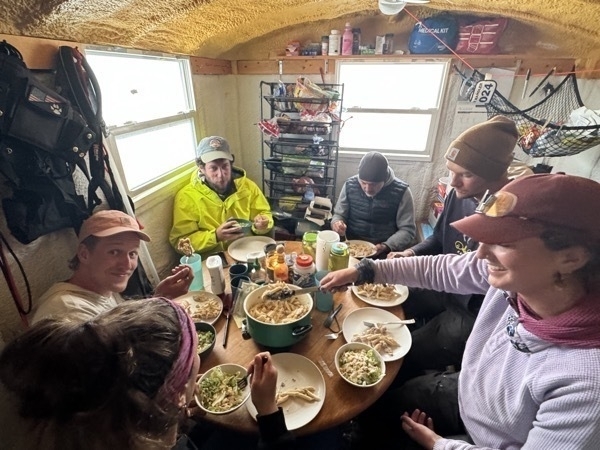
These are the dog handlers/mushers and our hosts
for the evening. Three of them slept in this tiny “kitchen” while the other couple and us slept in their huts.
Great Alaska Helicopter Tours could not have not have tried harder to get us back to down to their base in Palmer earlier. The company tried until dark (around midnight) the night we got stuck and then began trying again at first light around 4:00am.
Helicopter arrives at 9:45 am!!!
Finally, the helicopter was able to poke through the clouds and we were elated.
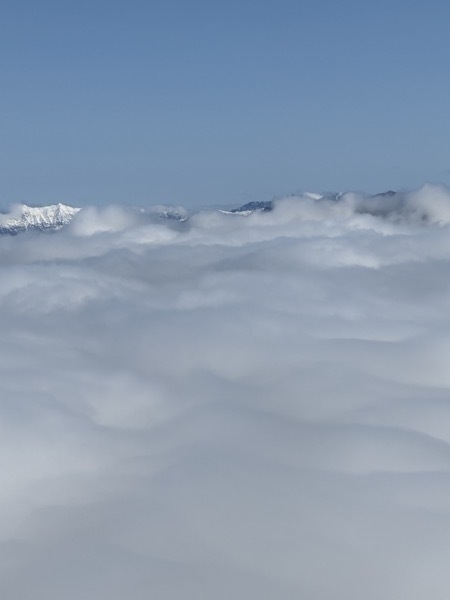
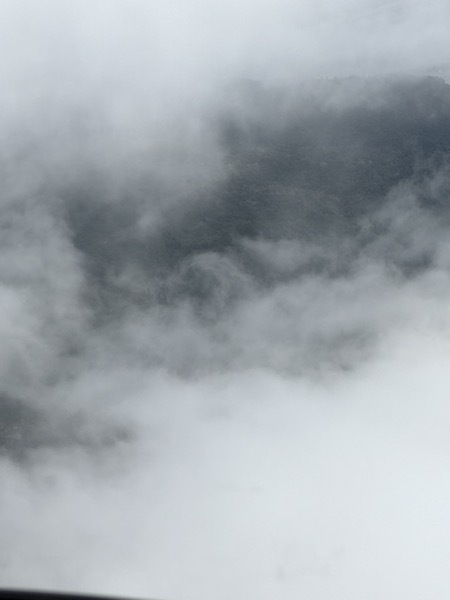
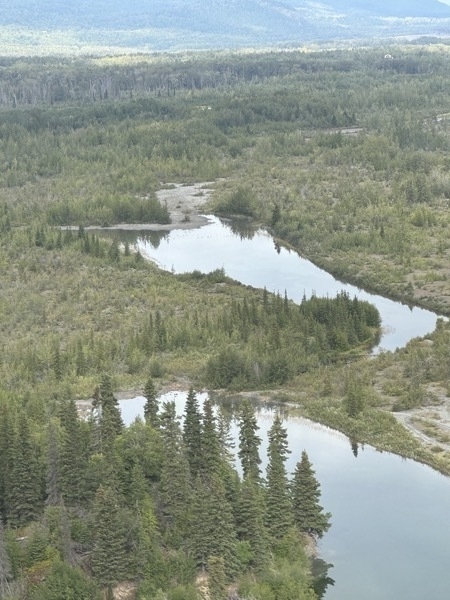
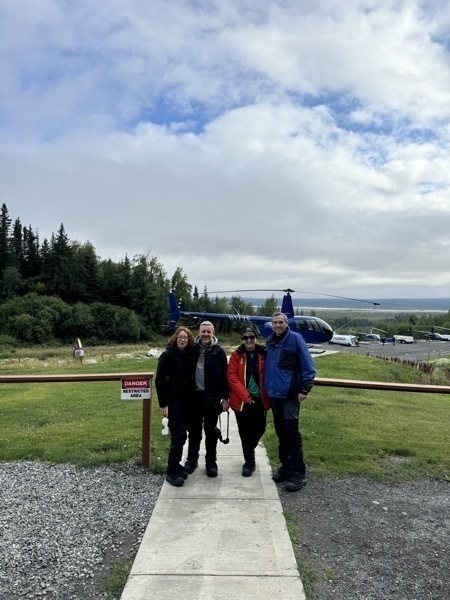
Here we are back at the base camp with Dan and Liz, the other couple stuck on the glacier with us who are from England. An interesting side note is that Dan is in construction and was the glass contractor for all the glass in The Shard in London.
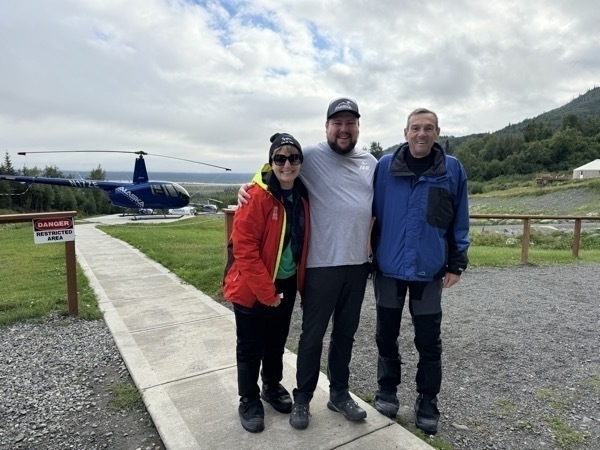
When we finally got back to the base, the owner apologized over and over for our inconvenience and gave us a full refund.
Another adventure in our Alaskan saga!
-
The Anniverary We Will Never Forget!
Our 36th anniversary began pleasantly in Dawson City, Yukon with a sweet love note from Tom. However, while I was having breakfast, I chipped a part of the back tooth on my left side (the one near my tongue). Little did I know, this was just a hint of how the rest of our day would unfold!
We left Dawson City, Yukon around 11:00 am by riding the ferry across the Yukon River to begin our journey on the Top of the World Highway with plans to spend the night in Tok, Alaska.

The Top of the World Highway is known for its dramatic landscapes and remote beauty and offers a unique driving experience. The road is predominantly unpaved, comprising graded dirt and gravel, with a combination of smooth stretches and rough, washboard sections. Some areas have soft edges, requiring careful navigation. The highway includes narrow segments with sharp turns and switchbacks that traverse mountainous terrain, with certain sections featuring steep drop-offs. The road is extremely remote, lacking amenities, cellphone service, or emergency assistance.
The highway crosses the International boundary between Canada and the United States where travelers must go through customs and immigration procedures.
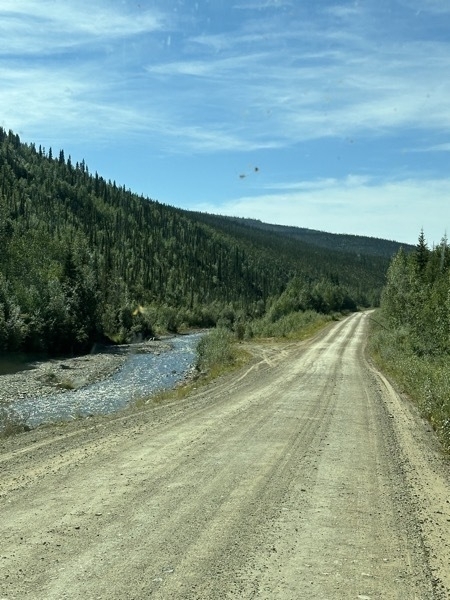
Top of the World Highway
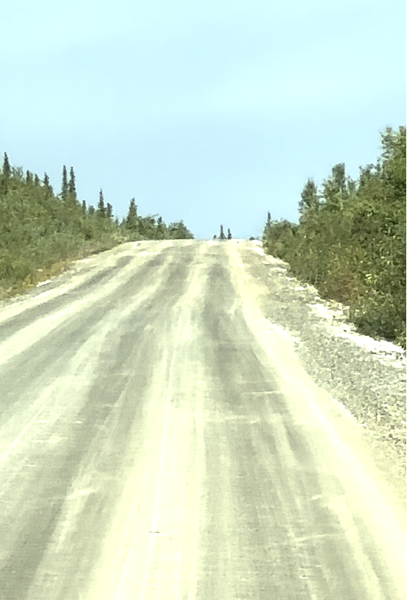
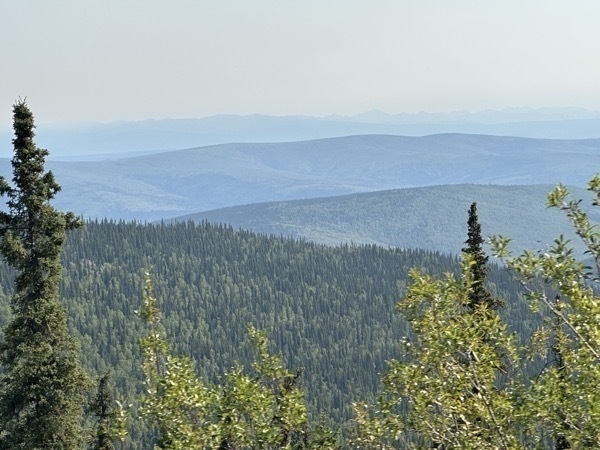
Beautiful vistas
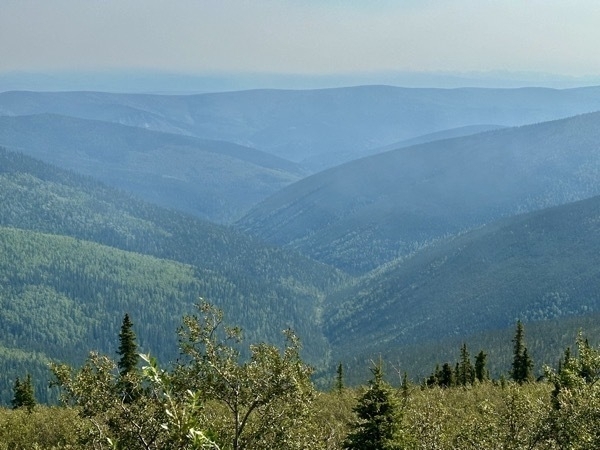
It was a little smokey but the views were still beautiful.
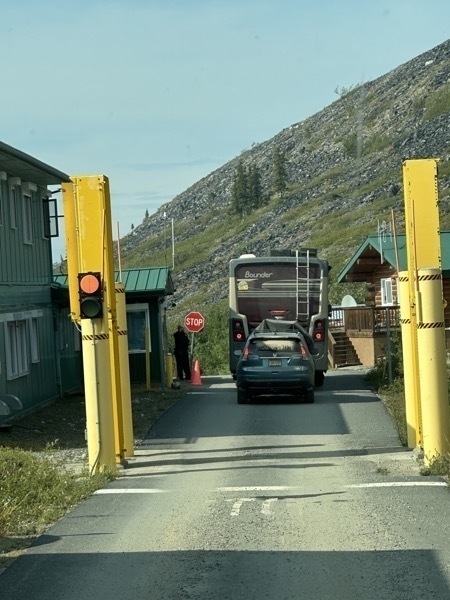
We had to stop at the border to be processed by customs.
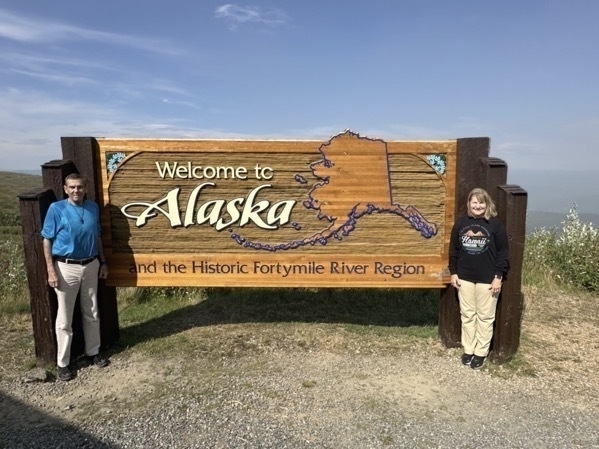
Back in the USA after spending 31 days driving through Canada. We arrived at the Alaska state line around noon and stopped for our obligatory photo by the sign.

Most of the road was a graded dirt surface with deceptively soft edges, which we hadn’t anticipated. Fortunately, this happened just before a steep drop-off. The road sees frequent traffic from Class A motorhomes and fifth-wheel trailers, some of which occupy more of the road than others. As Tom maneuvered to give space to an approaching vehicle, the soft edge gave way beneath us. Despite his efforts to correct the vehicle’s trajectory, we seemed to topple in slow motion. Thankfully, the poplar trees and shrubs acted as a barrier, preventing us from sliding further down the mountain and keeping us precariously, but safely, in place.
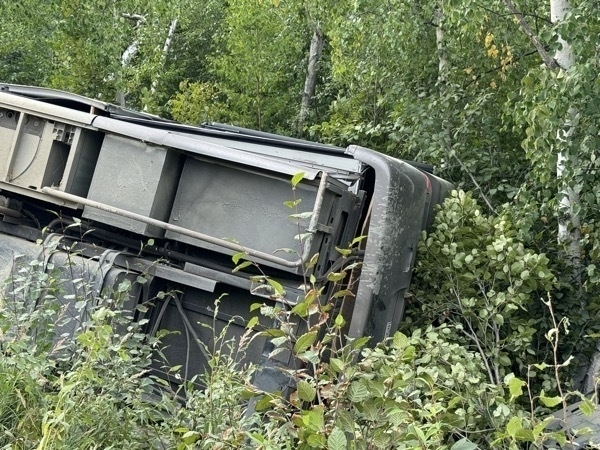
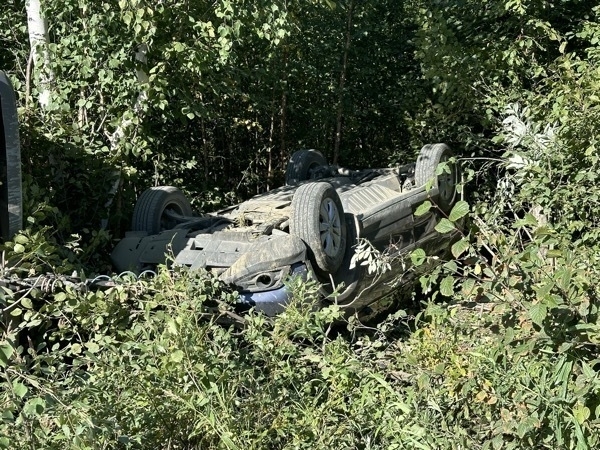
Our next challenge was extricating ourselves from the motorhome, which now lay on its side like a toppled giant. The poplar trees we had braced against seemed to be our only hope of holding it steady, but their grip was uncertain. We faced the daunting task of climbing up to a side window—now positioned on top, a full 8.5 feet above us.
Tom leveraged his height and long legs to scale the toppled belongings and pull himself out, but I struggled to manage the climb. Amid the chaos, several passersby stopped to offer assistance, and three motorcyclists truly went above and beyond. One of them, displaying incredible bravery, climbed into the motorhome to help me. He lifted me up by having me stand on his back, while the other two men, stationed on top, pulled me through the window. Their selflessness and heroism were nothing short of extraordinary! God’s grace and the kindness of strangers played a crucial role in our rescue.
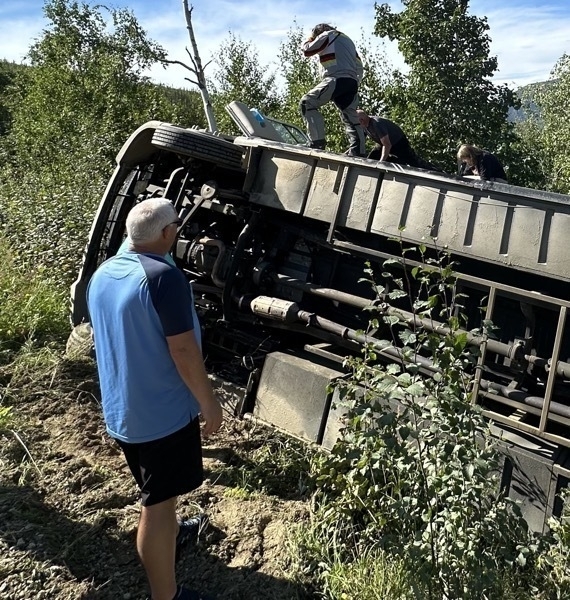
This picture shows me climbing through the window with the men who helped me still up on top.
With no cell service, a kind stranger who had stopped to assist, drove me to an RV park thirteen miles away in Chicken. Although the park had only limited Wi-Fi, the owner graciously allowed me to use her satellite phone. From there, I coordinated with a tow company to dispatch trucks from five hours away and contacted our State Farm insurance agent Linsey Cutler.

Tom remained at the accident site. Although it was only 13 miles away, it was a 45-minute drive. After I arranged for two tow trucks for the following day, two men kindly offered me a ride back to the site. By the time I returned, the Department of Transportation and State Police had arrived. After the accident report was completed and a sign reading "ALL OK" was posted on the motorhome, Daniel from the DOT gave us a ride back to the campground.
We were left with nothing but the clothes on our backs and no essentials. Thankfully, we found refuge in a log cabin at the RV park, though it had limited facilities—the showers and three outhouses were a down the road. There was nowhere to buy a toothbrush, toothpaste etc. Two strangers at the RV park (news travels fast) brought us toothbrushes, toothpaste and a bar of soap.
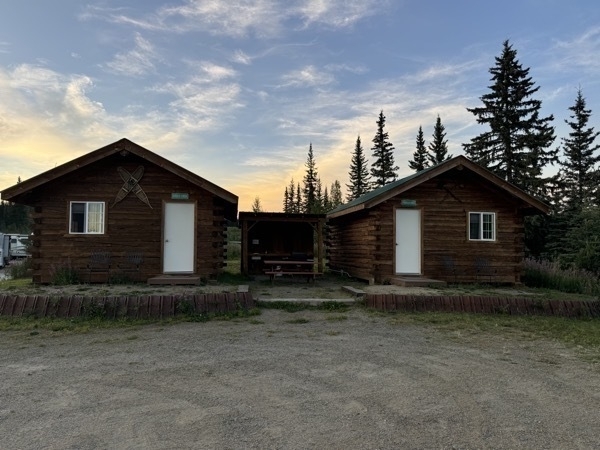
We stayed there for two nights since we were still 60 miles from Tok, the closest town with cell service, and 280 miles from the nearest car rental agency in Fairbanks.
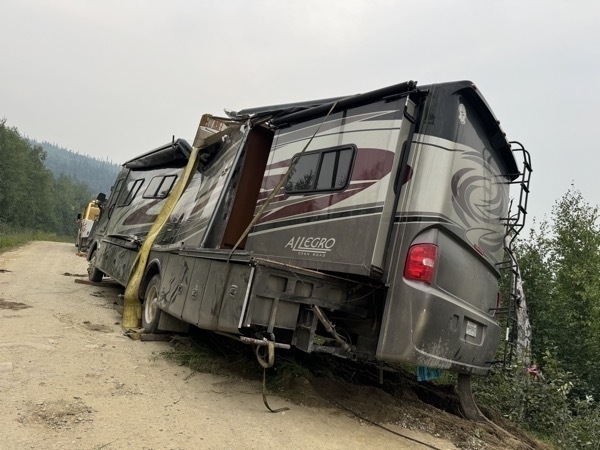
Meanwhile, the motorhome and car were pulled from the side of the mountain and placed upright. We were stunned by the sight of our once-beautiful coach in its current condition.
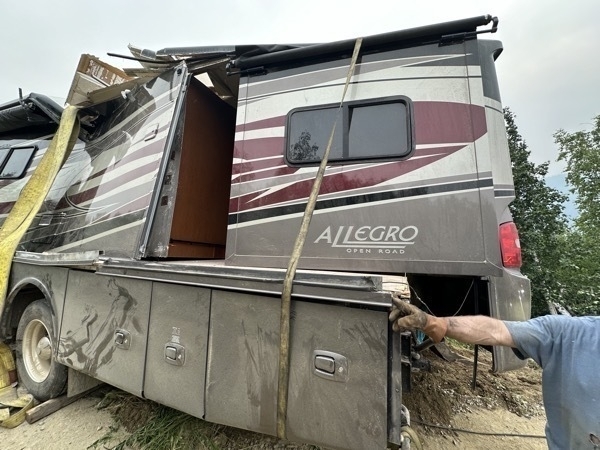
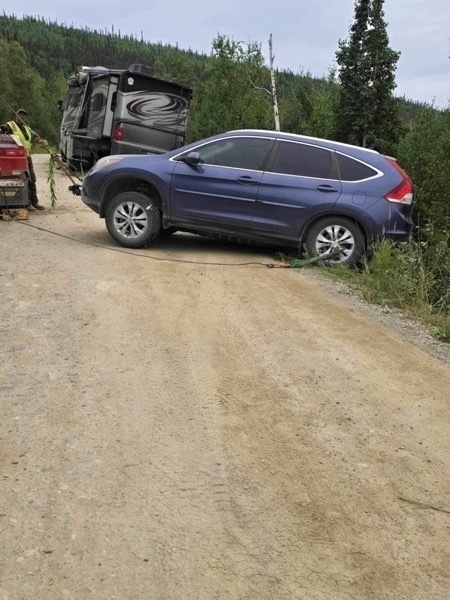
Given that the car had been upside down for two days, its condition wasn't as severe as we expected. While the three other sides are dented and the front windshield is crushed, it is now upright and waiting to be towed.
Doug and Bonnie Dontje, an incredibly generous couple we had just met at the campground, kindly loaned us their Jeep truck. We used it to revisit the accident site multiple times to monitor the tow trucks’ progress with the car and motorhome. On August 9th, we drove their Jeep to Glennallen to retrieve what we could from the motorhome.
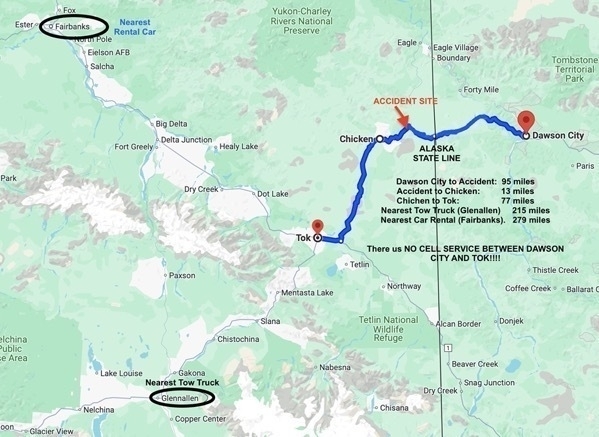
Map of our accident site as well as the places we had to drive
Due to the severe damage to the motorhome and the sides being strapped to keep it together, the tow company prohibited us from entering the vehicle. One of the workers managed to climb through two separate windows, and retrieved as much of our clothing, shoes, and other belongings as he could reach. What would normally been a walkable area, even with all the slides in, was now impassable. Six drawers in the bedroom containing clothing were unreachable, as was the bathroom medicine cabinet. Additionally, the large storage bays underneath, which held the air compressor, pellet grill, lawn chairs, lights, and other bulky items, were also inaccessible.
We have no idea what the insurance company is going to do with this claim, but we were told it cost $16,000 to tow the motorhome and $10,000 to tow the car from the accident site to Glennallen.
The borrowed Jeep truck was packed to its limits! We continued our drive from Glennallen to Fairbanks, covering a total of 484 miles for the day.
We checked into a hotel and unloaded the Jeep, utterly drained. The following morning, we rented a car, picked up some boxes from U-Haul, and went back to the hotel to begin packing our belongings. Once we finished, we drove the borrowed Jeep to the Fairbanks KOA, where Bonnie and Doug Dontje had arrived in their motorhome.

After spending two nights in Fairbanks we drove to Anchorage and rented a 22’ Minnie Winnie motorhome and returned the rental car.
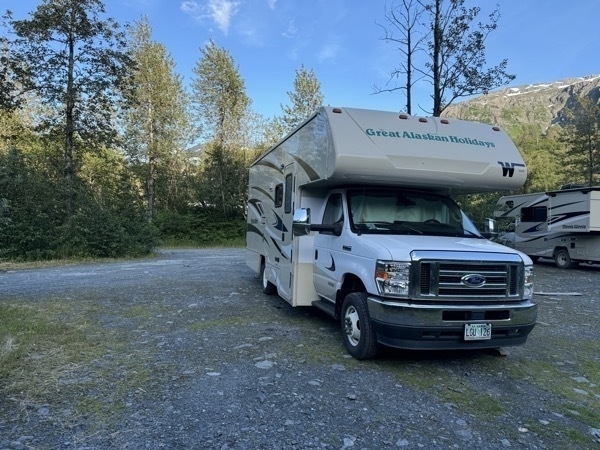
Our insurance agent, Lindsey Cutler, has been incredibly supportive, arranging our rental car, diligently managing our claims, and offering emotional support throughout the process.
Through this challenging ordeal, we’ve experienced overwhelming generosity and support. God is good, and we feel incredibly blessed.

-
Whitepass Railroad to Skagway
Today was a perfect day to take trip down to Skagway. A Bus picked us up at the campground at 8:30am and drove us to Fraser, BC. The ride usually starts at Bennett but because of a huge rock slide across the road and tracks, we had to go to the next little town to board the train. Construction of the amazing White Pass Railroad path began in 1898. The railroad began construction in 1898 during the Klondike Gold Rush as a means of reaching the gold fields. With its completion in 1900, it became the primary route to the interior of the Yukon, supplanting the Chilkoot Trail and other routes.


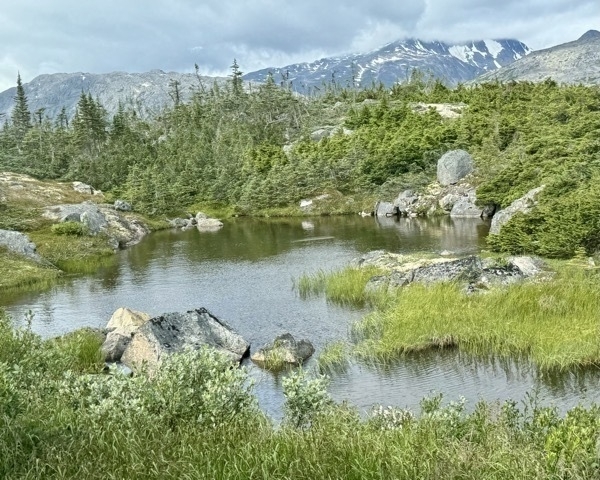

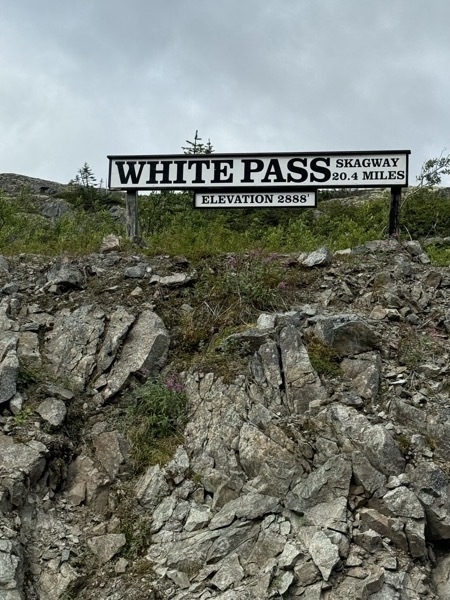
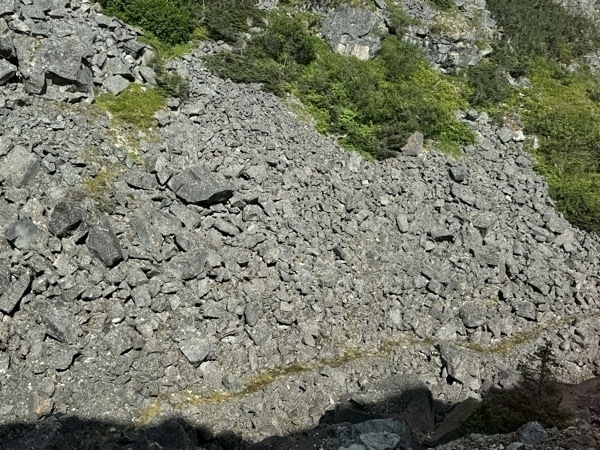
Towards the bottom of the picture is the remains of the original Whitepass Trail used in the 1800s by the men crossing the mountain in search of gold.
Famed Steel Cantilever Bridge
This 215’ high structure was the tallest railroad bridge of is kind in the world when built in 1901. It was designated as an International Historic Civil Engineering Landmark, a title shared with other famous structures such as the State of Liberty and Eiffel Tower. This bridge spans the gorge that was known as Dead Horse Gulch where over 3,000 pack animals lost their lives. Horses, purchased from glue factories in Seattle, were sold at the Skagway docks for ridiculously high prices. The gold stampeders treated these horses so harshly and when they died, pushed them into the gulch.

Steel Cantilever Bridge
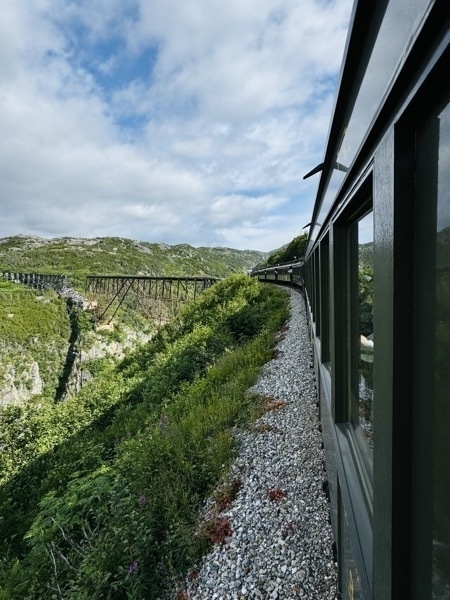



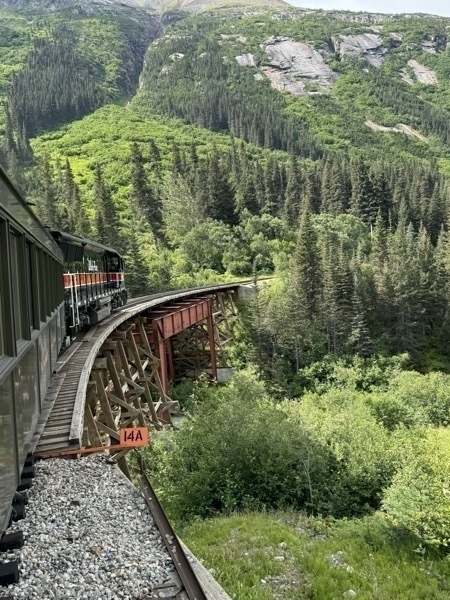

In 1922, George Buchanan, a wealthy coal baron from Detroit began sponsoring trips to Alaska for young boys, At milepost 8.8, grateful “Buchanan Kids” surprised their benefactor by crossing the canyon and painting their slogan on the rocks face. Every few years, volunteers from Skagway venture up to repaint this unique piece of history.
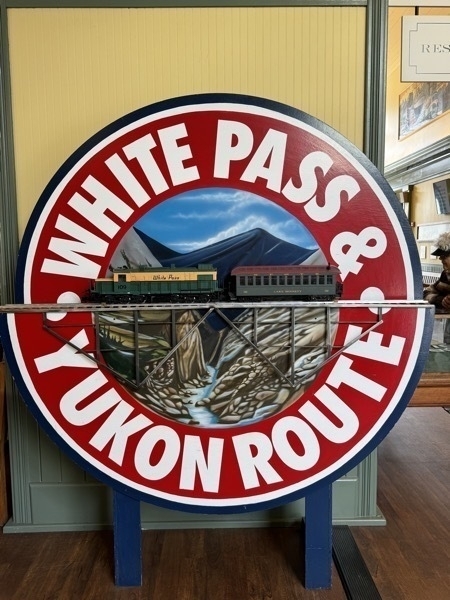
Sign at the RR station. In Slagway

Skagway RR Station
After arriving in Skagway, we ate lunch at the Bonanza Bar & Grill and walked through the stores and visited the Klondike Gold Rush National Historical Park. We boarded our bus near the train station and rode all the way back to our campground, arriving around 6:00 PM.

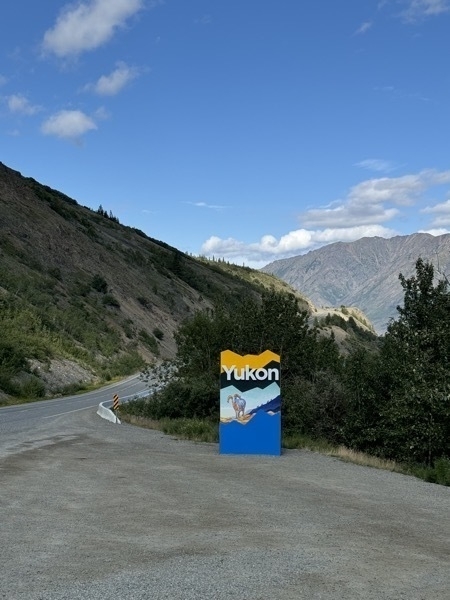
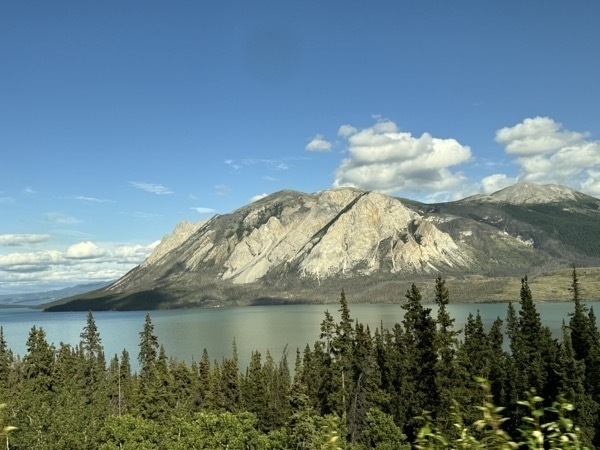
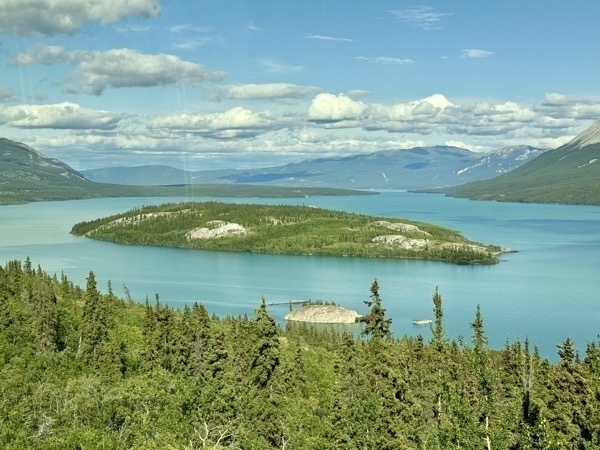
We had a short stop in Carcross on the way back to Whitehorse, but the stores were already closed for the day.
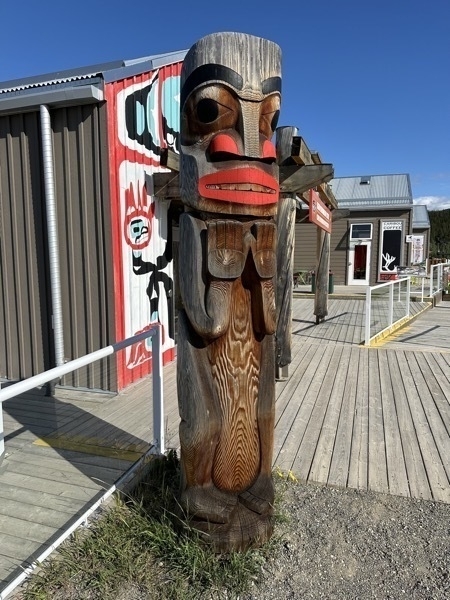

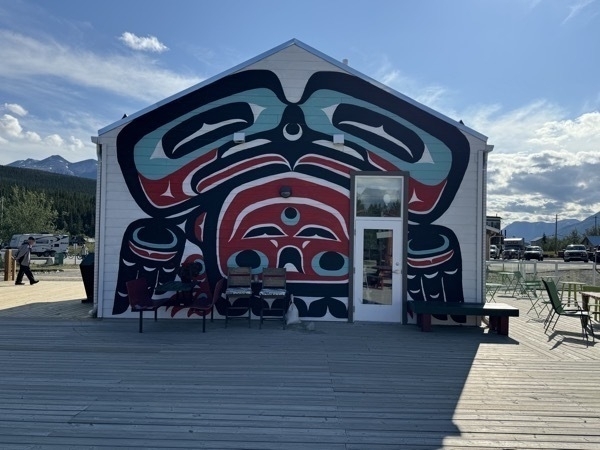
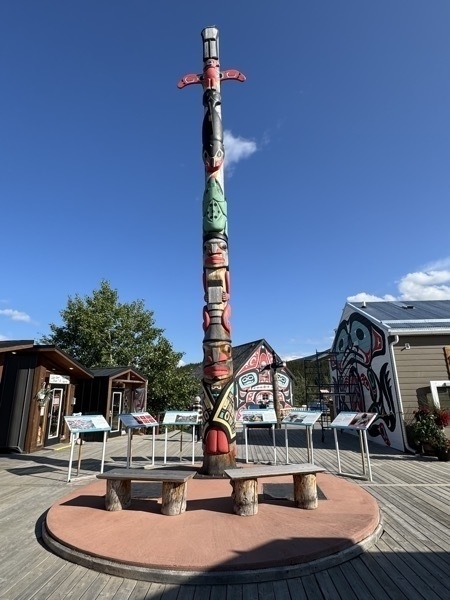
Carcross “Desert"
This tiny square mile of Canadian sand was once considered the world's smallest desert. it’s actually not a desert at all. It’s a series of sand dunes that are kept dry by the rain shadow effects of the mountains in Yukon’s southern lakes region.
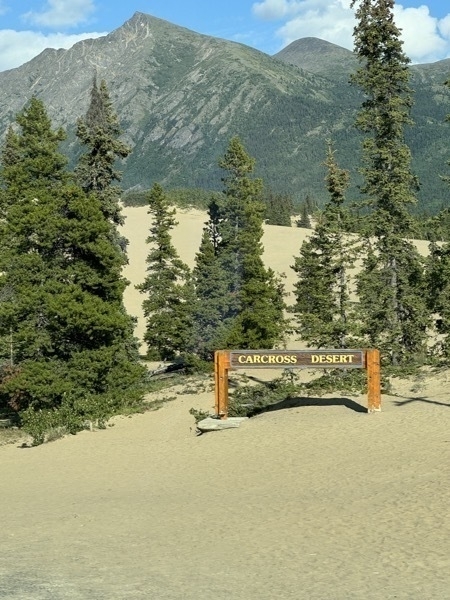

-
Days 36 and 37 Whitehorse, Yukon
In driving from Teslin to Whitehorse, we crossed the border from the Yukon to British Columbia and back to Yukon. Whitehorse is located at Historic Milepost 918 of the Alaska Highway. The town is located along the Yukon River and has a population of 28,201.

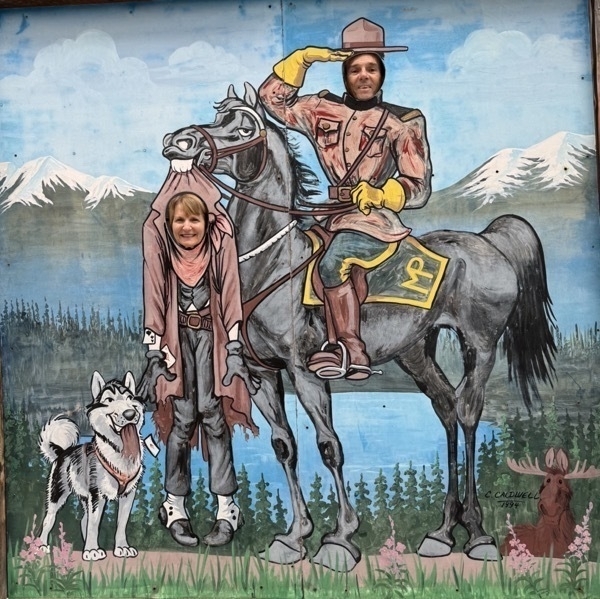
Yukon Legislature Building
Whitehorse has been the capital city of the Yukon since 1953. The current Legislature Building was built in 1974 and replaced the former building which was a log cabin. The Yukon is a Canadian territory rather than a province and only has 19 representatives.
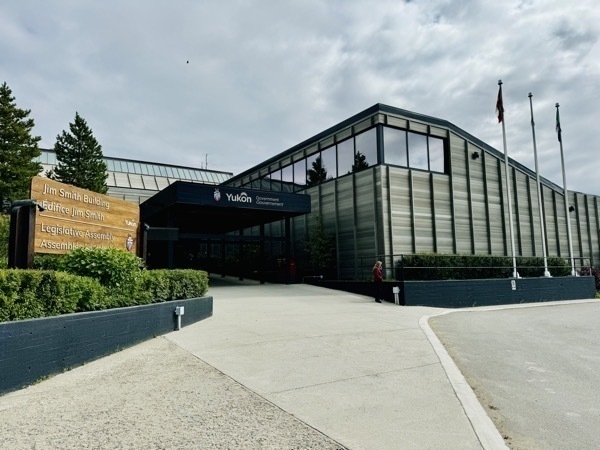
Whitehorse Legislature Building

Legislature Chamber
Miles Canyon
We drove over to the Miles Canyon area of the Yukon River and walked two miles across the bridge and along the river.
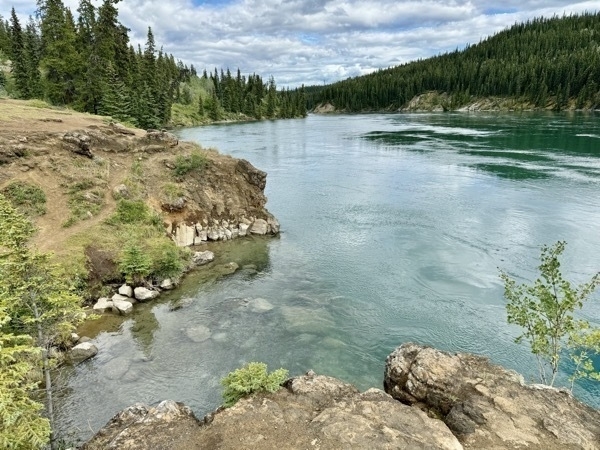
World’s Largest Wind Vane
Located in front of the Yukon Transportation Museum is the world’s largest wind vane—a Douglas DC-3. This vintage plane was originally a C-47 that was built in 1942 and flew transport missions in Asia during the war. Afterwards, the plane was converted to a DC-3 and flew for Canadian Pacific Airlines, Connelly-Dawson Airways, Great Northern Airways and Northward Airlines from 1946 - 1970. The airplane was restored and mounted on a rotating pedestal base which keeps the nose of the plane always facing the wind.

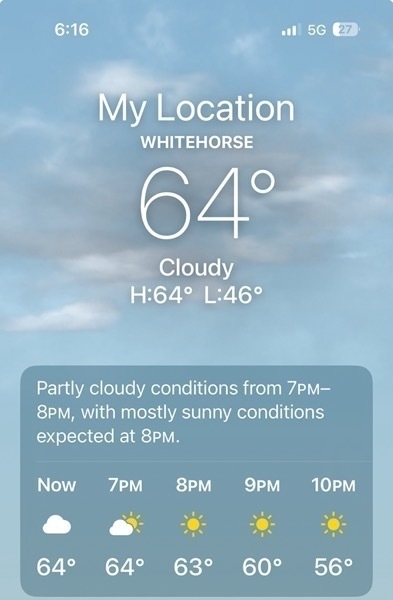
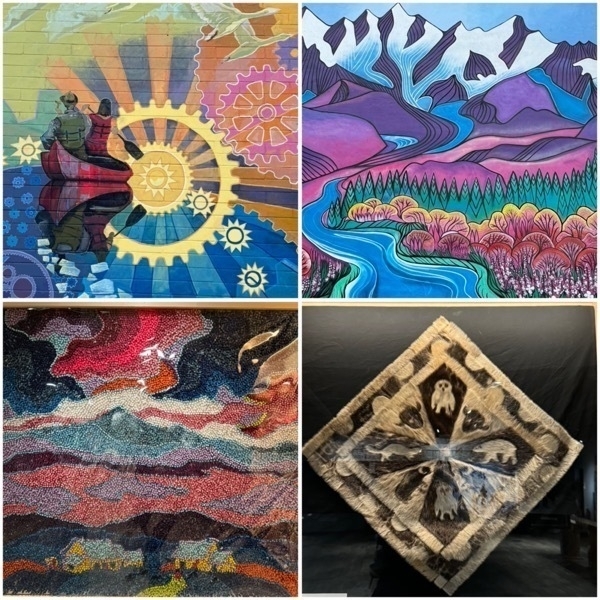
The top two pictures are of murals on the side of two buildings in the downtown area. The bottom left is picture created with push pins. The bottom right was created with light and dark sealskins.
MacBride Museum

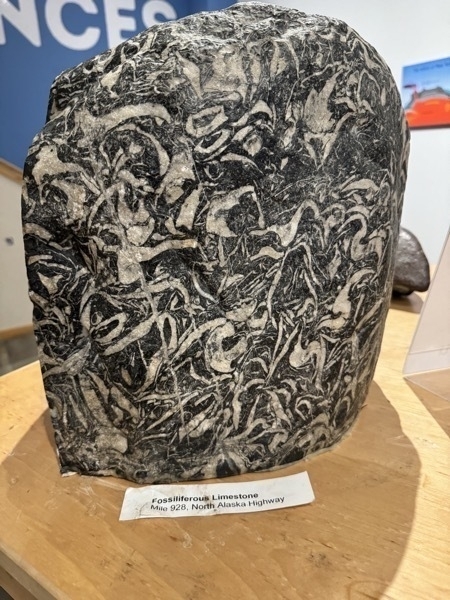
Fossiliferous Limestone found at Mile 928 on Alaska Highway

The beaver is the largest rodent in North America and one of Canada’s national emblems. Beavers can cut down trees in minutes with their long orange front teeth, which grow continuously. They have dark brown fur and a broad, flat and hairless black tail that can be up to 12 inches long. Beavers have broad, webbed back feet that make them excellent swimmers.
We camped at Hi Country RV Park and Campground in spot #65.
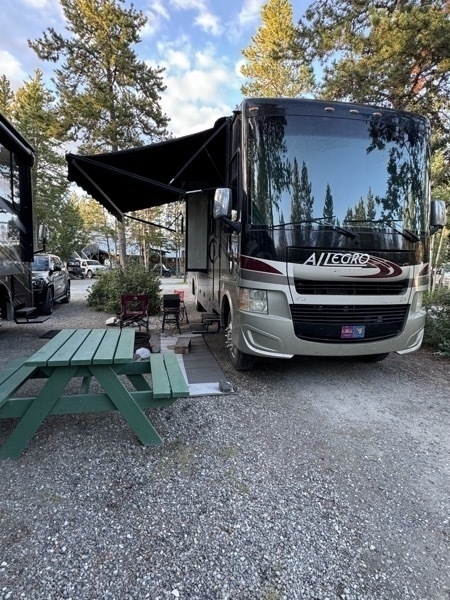
Trip Statistics
- We drove 108 miles in the motorhome and 32 in the car for a total of 5,001 miles
- We stayed at Hi County RV Park for $48.42 per night
- Gas was $5.22 a gallon for a total of $200.59 (We’ve spent $2551.24 on gas so far this trip)
-
Day 35 - Teslin, Yukon
We left Laird River, British Columbia late in the morning and drove 162 to Teslin. Teslin is Historic milepost 804 on the Alaska Highway. The population is 239. The average temperature in July is 57 degrees.
This was truly just a stopover for the night as we didn’t even bother unhooking the car. After dinner we walked around the campground to look at everyone’s license plates to see what US states were there as we always do. There were some HUGE rigs that were traveling together.

This is the third time we’ve seen this type of set up with such a big truck pulling a fifth wheeler. There were two of these big diesels pulling fifth wheelers, but this was the only one with a car also.
There were some native animals on display at the campground gift store. A particularly interesting one was of these caribou. The sign explained that these two bulls were testing their strength during mating season. They locked their antlers in combat and were unable to free themselves and died of exhaustion and dehydration. These were discovered in the Ogilvie Mountains.

The second longest bridge on the Alaska Highway crosses the Nisultin River going across the river into Teslin. Our campground was on the right after crossing the lake.
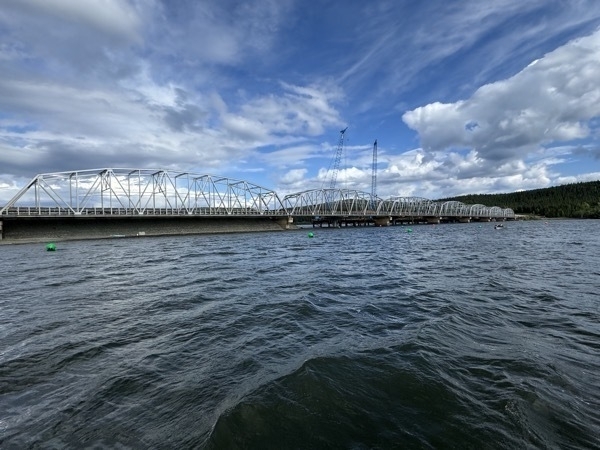
As our luck would have it, a second bridge was being built on the side of the original bridge and we listened to construction vehicles all night long. In addition to the noise all electricity was turned off from 9:00pm to the next morning.


Trip Statistics
- We stayed at the Yukon Motel and Lakeshore Campground for $42.97
- We drove 162 in the motorhome and 0 in our car for a total of 4,850 miles so far.
-
Days 33 & 34 Watson Lake, Yukon
We left Liard Provincial Park and drove 160 miles to Watson Lake . It was cloudy all day but it was still a beautiful drive.
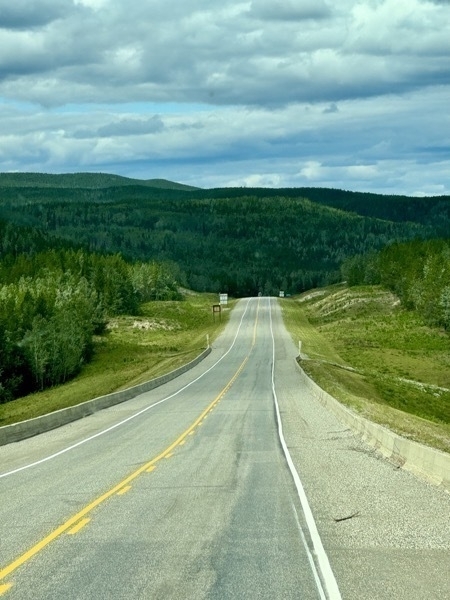

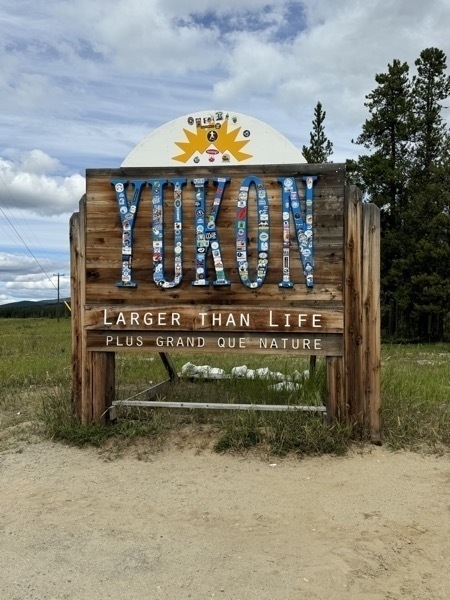
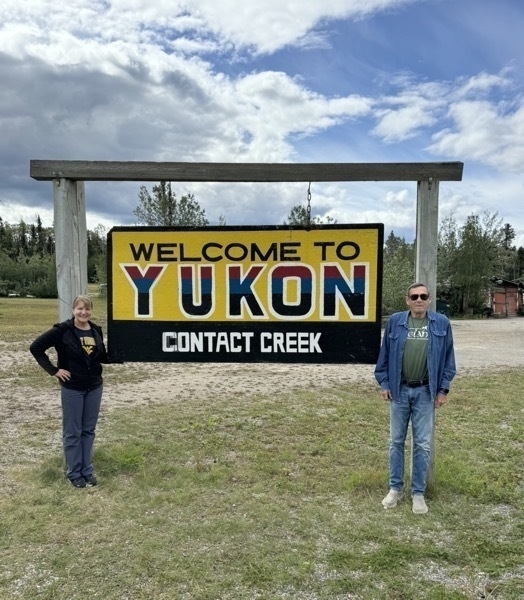
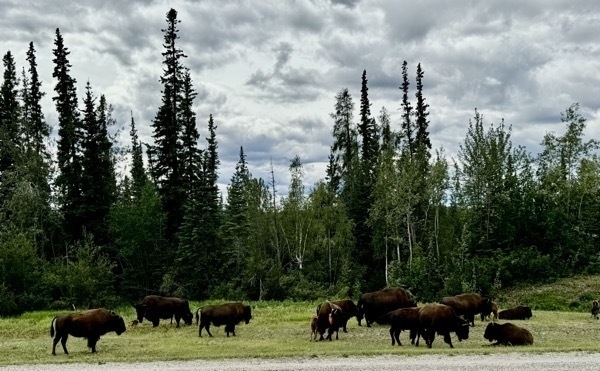
Watson’s Lake Sign Post Forest
The world famous Sign Post Forest has been attracting visitors since 1942. The tradition began during the construction of the Alaska Highway, when U.S. soldier Carl K. Lindley was recovering from an injury at an aid station in what has come to be known as Watson Lake, Yukon. A commanding officer asked Lindley to repair and erect directional signposts, and while completing the job, he added a sign that indicated the direction and mileage to his hometown of Danville, Illinois. Other homesick soldiers followed suit and the trend caught on eventually growing from a single signpost to a full “Forest”.
The Alaska Highway was constructed during the Second World War to provide a land based route to Alaska and ground support for the construction of runways and airstrips of the Northwest Staging Route. The Alaska Highway changed the landscape of the Yukon by increasing transportation routes, improving communication systems, altering settlement patterns and bringing new services and expanding economic opportunities throughout the territory.
The Sign Post Forest has expanded over the years to include licence plates, road signs, handmade plaques, and other quirky items that travellers leave behind, giving shoutouts to hometowns all over the world! Leave your mark today!

Fun Facts.
• As of 2023, there were close to 100,000 signs in the Sign Post Forest
• The Sign Post Forest was designated a territorial historical site on August 30, 2013
• The pieces of heavy equipment found in the Forest were used during the construction of the Alaska Highway
• In 1992, while celebrating the 50th anniversary of the building of the Alaska Highway, Lindley and his wife returned to Watson Lake and erected a sign replicating Lindley's original sign


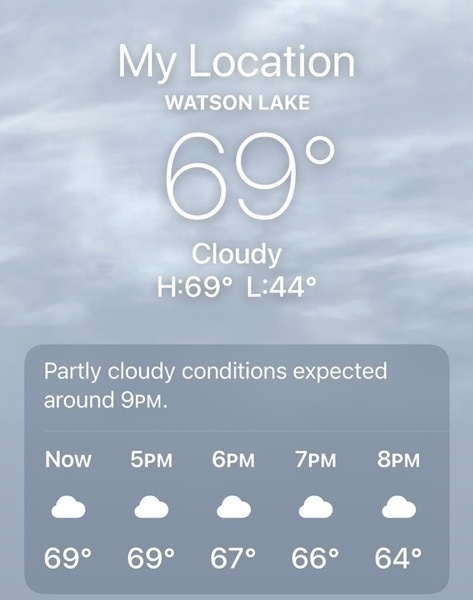

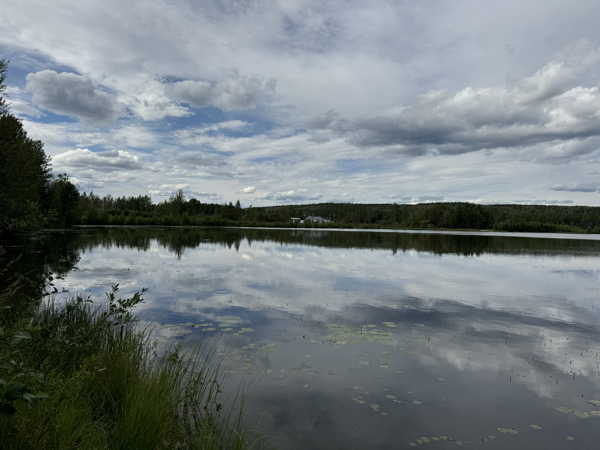
We stayed at the Downtown RV Park which was nothing but a flat gravel parking lot, but it did have full hookups. We were there with a Fantasy Tours Travel group with at least 14 Class As and 5th wheelers. Several of the rigs had the Starlink receivers which seems like a good idea in this area because of lack of reception in many places.
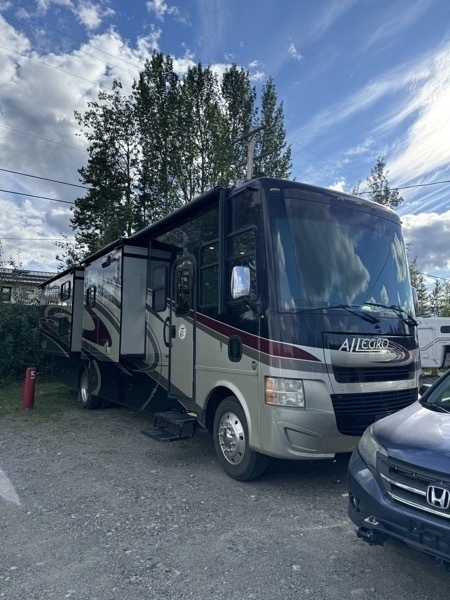
Trip Statistics
- Downtown RV park was 45.00 a night.
- We drove 160 miles in RV from Liard. We’ve driven 4,686 in the RV and car so far.
- We bought gas for $5.177 a gallon for a total cost of $251.81.
-
Day 32 Alaska Trip - Liard Hot Springs Campground
Even though it was cloudy all day, the drive from Fort Nelson to Laird Springs was very pretty. For most of the day we had no cell phone reception and very limited services along the route. The area is supposed to be rich in wildlife. We saw many signs by the road warning of moose, but we were disappointed we didn’t see any wildlife.

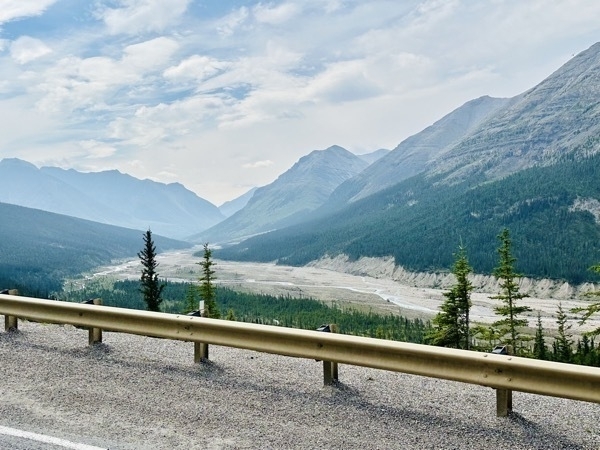
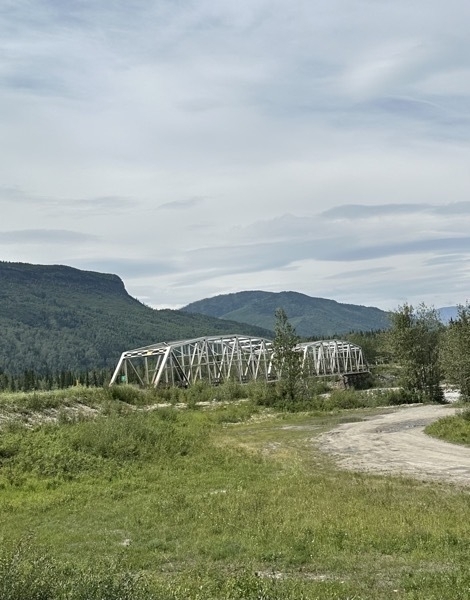
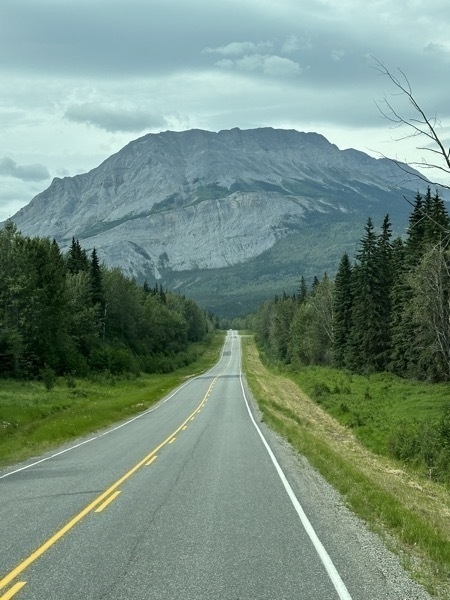
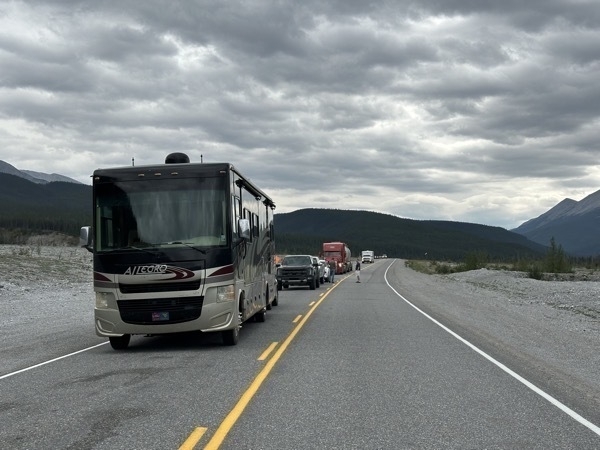
We had a 15 minute wait because of road construction.


Muncho Lake
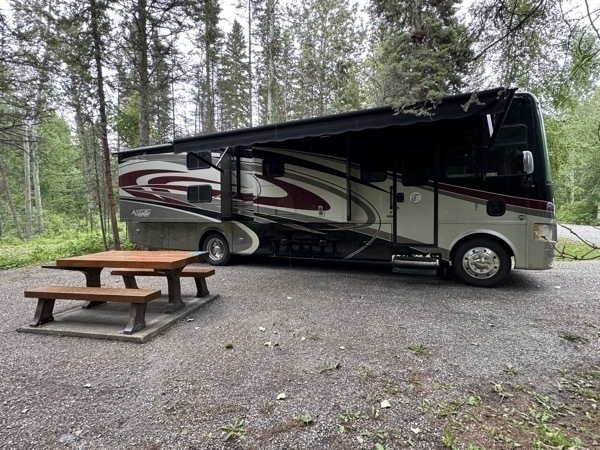
Our campsite was very private and level at Liard Springs even though we had no hookups. The weather was perfect for dry camping.
Liard Hot Springs
The Liard River Hot Springs are the second-largest known thermal spring complex in Canada, with at least six springs feeding into different pools and streams that drain into the marsh. The further from the source, the cooler the water.
The total volume of water flowing through the complex is 120 to 130 litres per second.
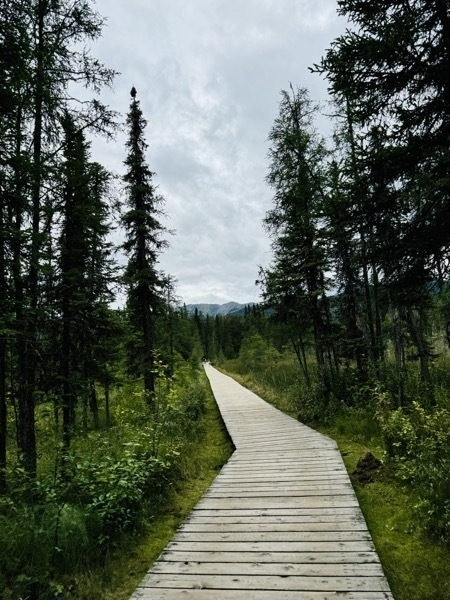
The walkway down to the springs

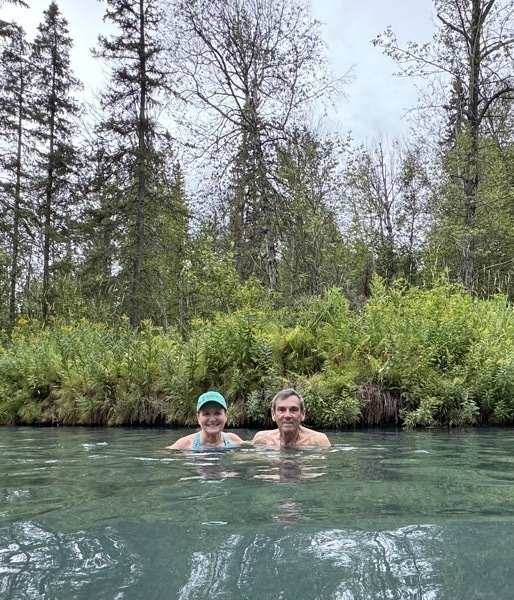
Trip Statistics
- Liard Springs Campground was 19.00 a night
- We drove 189 miles in RV. We’ve driven 4,510 in the RV and car so far.
- We didn’t have to buy gas today, but we’ve spent $5,200 on gas so far—by far our biggest expense.
-
Days 30 & 31 Alaska Trip - Fort Nelson
The drive from Pink Mountain to Fort Nelson was beautiful, but very isolated. the skies and the scenery were so pretty.. We saw very few vehicles going either direction, few stores and no gas stations.

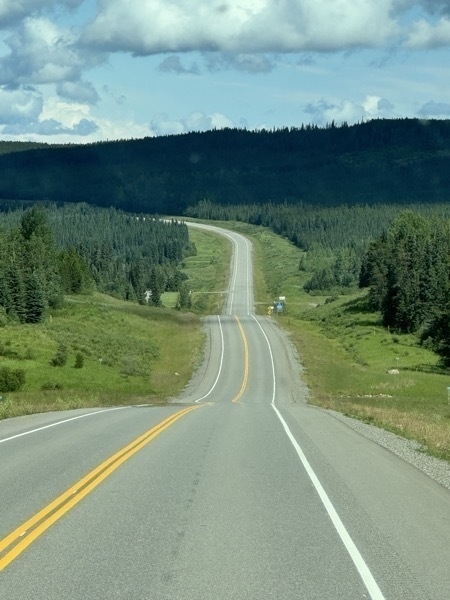
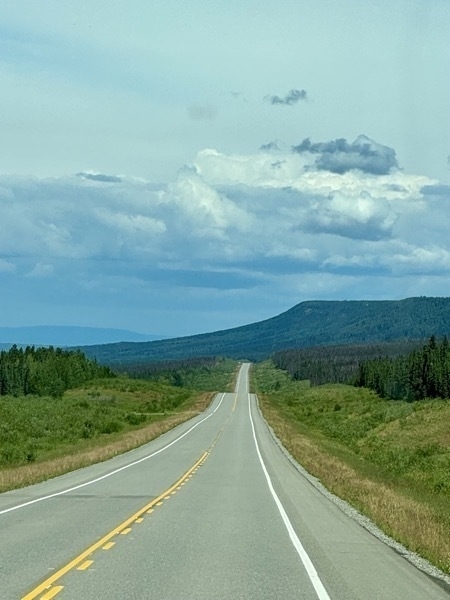
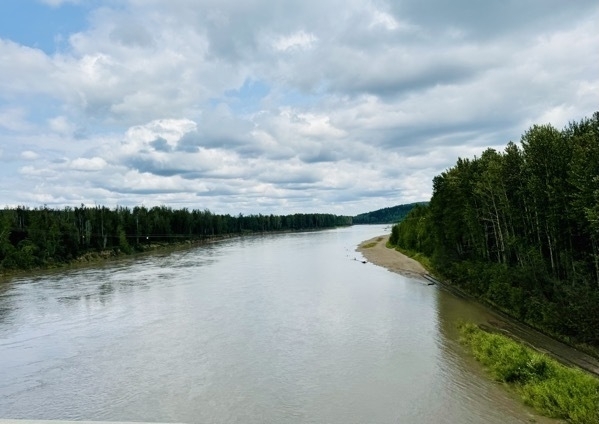
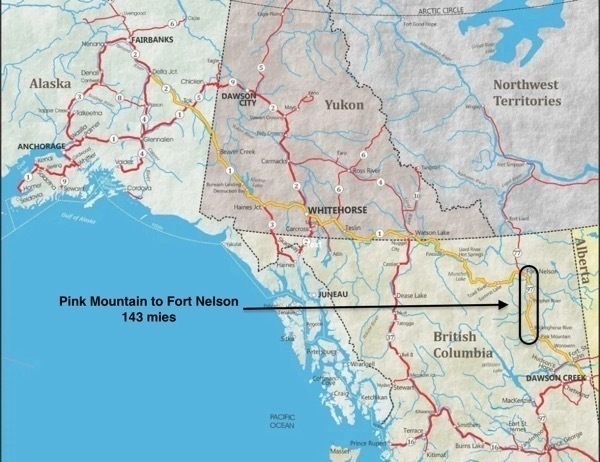
Our drive for today
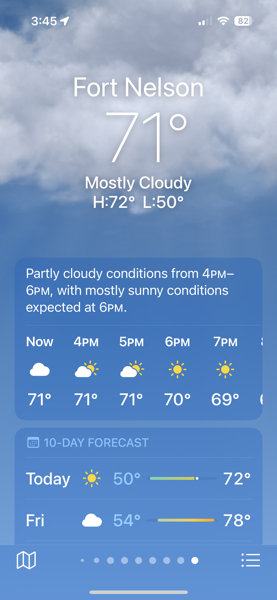
Beautiful two days in Fort Nelson. We’ve been so lucky so far to have only had rain on two different days for very short periods of time while we were driving and only two short light drizzles at campgrounds.
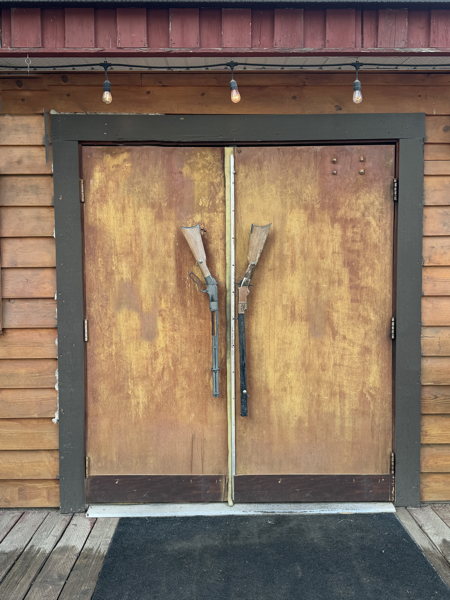
The doors to where we registered at the campground
In the evenings, we always walk around the campground to check out the license plates for all the campers to see where everyone was from. Although we’ve saw many states from as far away as us—or further: Rhode Island, Maine, Florida, etc,, We’ve seen TWO international campers. One from Germany and this one from FRANCE. This camper is in the process of driving from the Antarctic Ocean to the Arctic Ocean!

Fort Nelson, BC

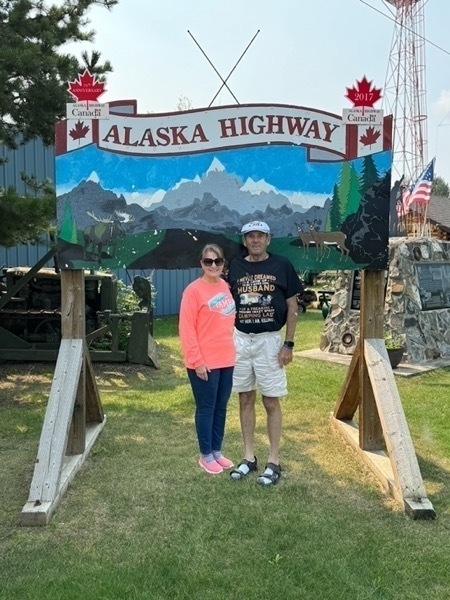
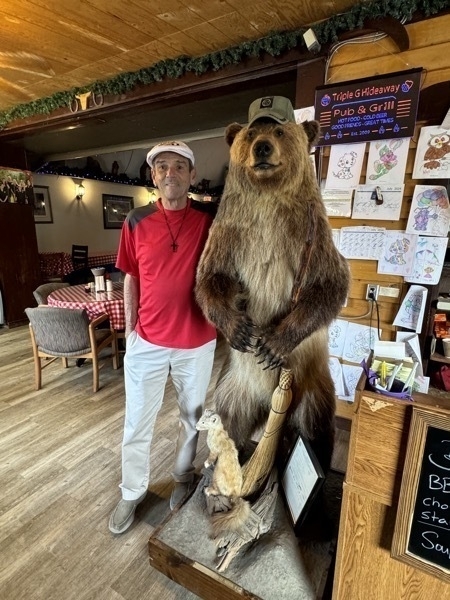
The city was having a festival right beside our campground with a live band and two huge food. There was a huge crowd considering the town only has a population of around 3,200.

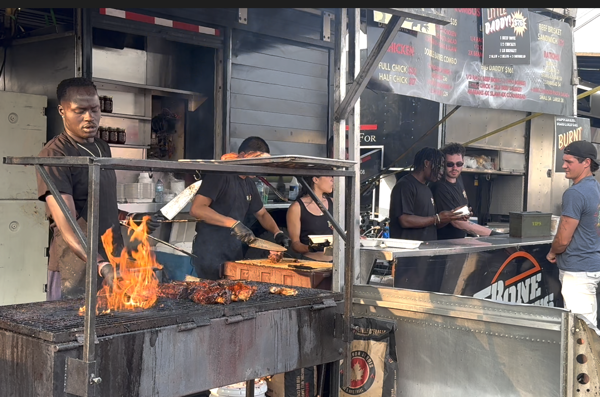
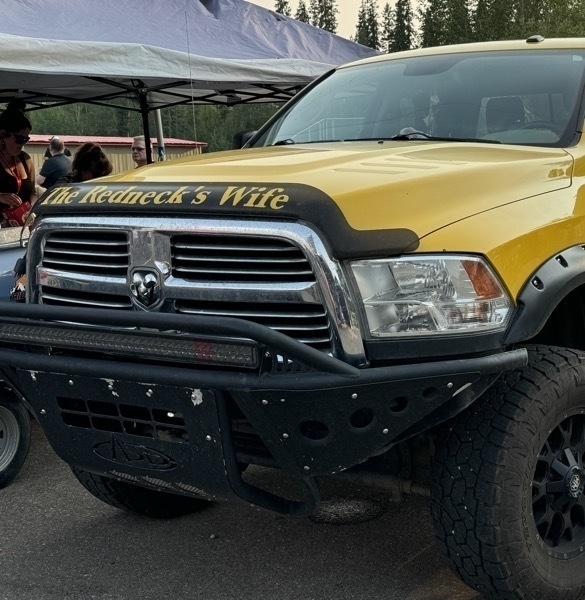
This truck belongs in Louisiana!
Trip Statistics
- Triple G Hideway RV Park was $38.35 a night
- Drove 143 miles in RV. We’ve driven 4,309 in the RV and car so far.
- Gas today was $5.31 a gallon for a total of $290.29
-
Day 29 Alaska Trip - Pink Mountain
Before we left Dawson Creek I went to the Bottle Depository and got $2 of our can deposit—10¢ for each can. So far we’ve gotten $4.20 for returning cans.
It was a beautiful 139 mile drive today from Dawson Creek to Pink Mountain.

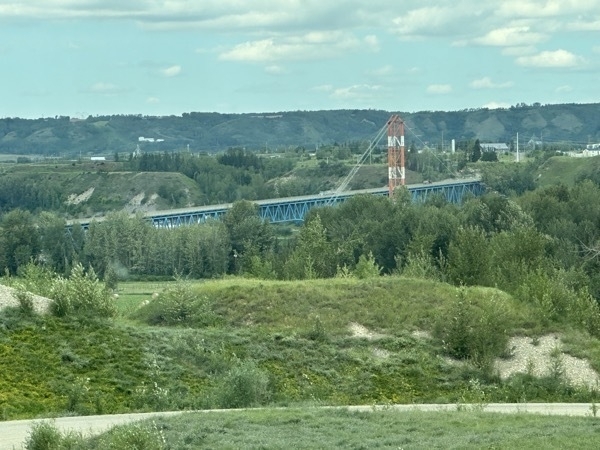
The red and white pillars are supporting a pipeline bridge. The bridge we crossed is the blue structure behind it.


I enjoy having my computer desk in front of me when Tom is driving.
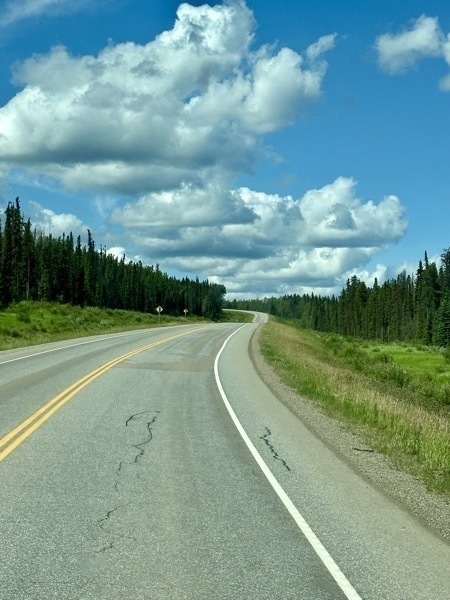
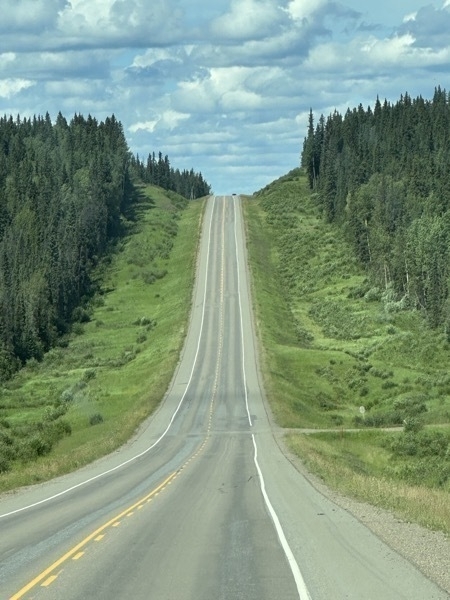
After traveling across flat land all the way through Manitoba, Saskatchewan, Albert and the bottom of British Columbia, we are now seeing some hills.
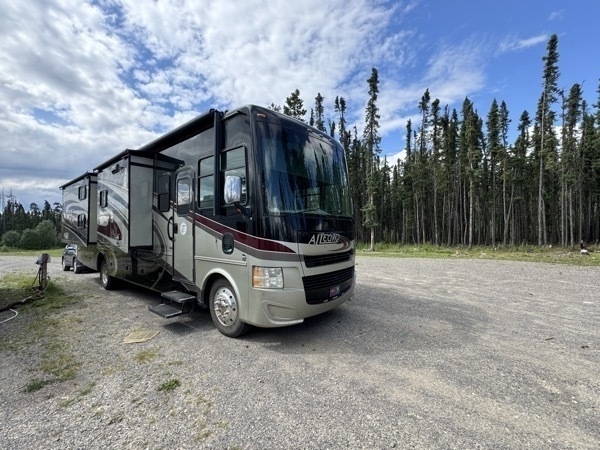
Our campsite at Pink Mountain turned out to be nice because no-one showed up to take the two spots on the right of us.
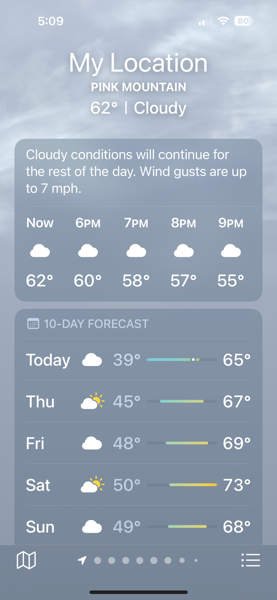
Trip Statistics
- Distance driven in the RV - 139,
- Distance driven in car today - 5
- Total Trip distance driven so far 4,159
- We stayed at Mile 0 Park & Campground $36,35
-
Day 29 Alaska Trip - Dawson Creek Day 2
This morning we toured the Dawson Creek Visitor’s Center and watched two videos about the construction of the Alaska Highway.
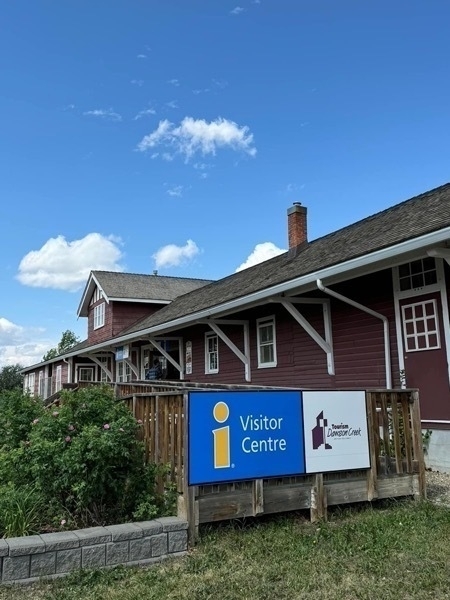
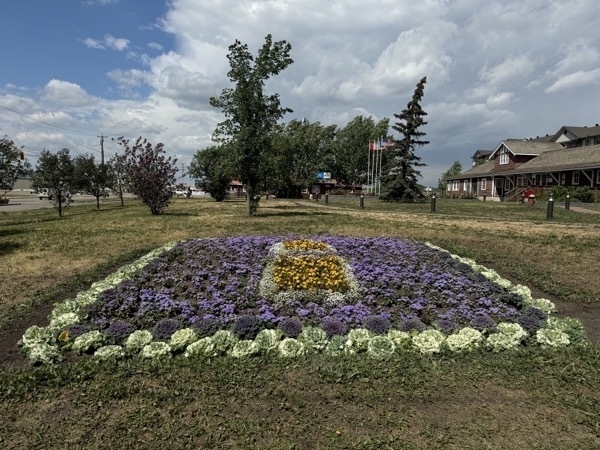
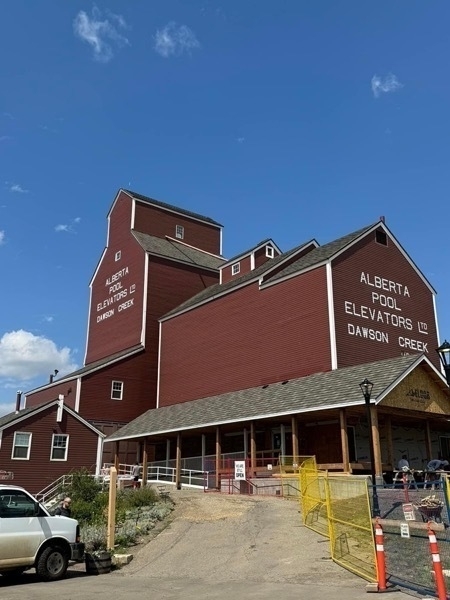
This grain elevator is now an art gallery. The art is displayed on the walls is a spiral slope all the way to the top of the building. In a room at the very top is a large classroom where a variety of classes are offered.
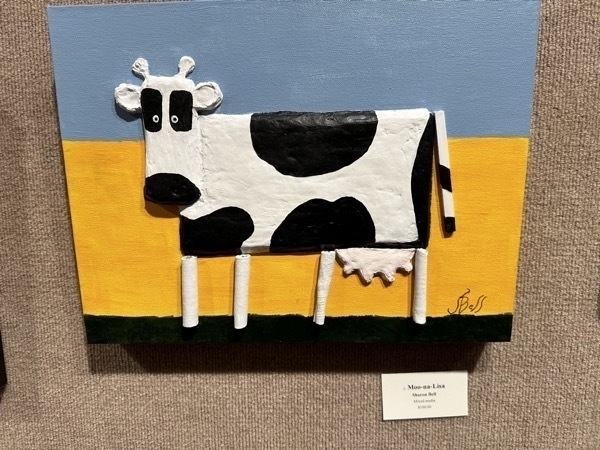
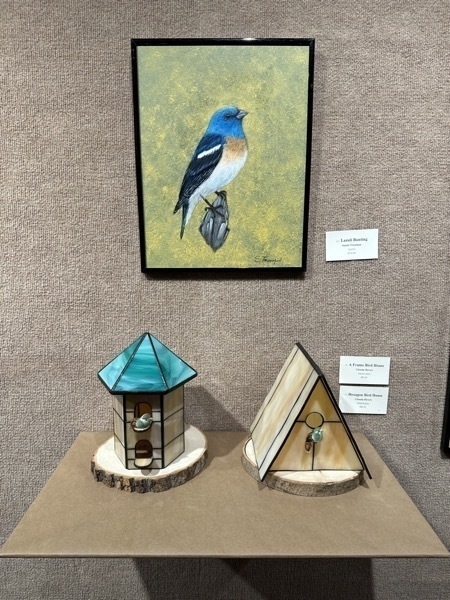
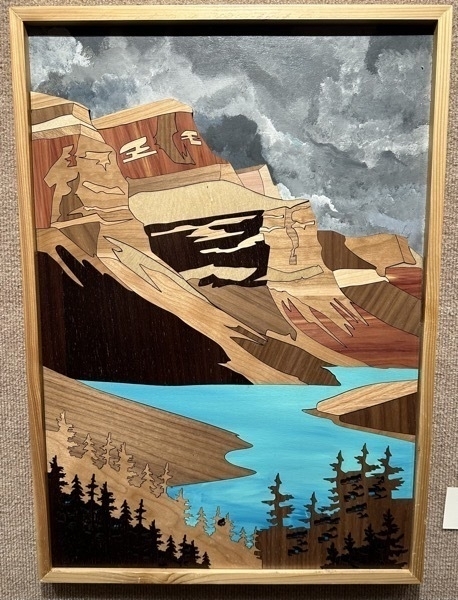
While we were touring the Walter Wright Pioneer Village at our campground I got a phone call from Susan Lowry (Tom’s first cousin from Norco, LA). She and husband Johnny were also in Dawson Creek and were driving over to the Pioneer Village to meet us.
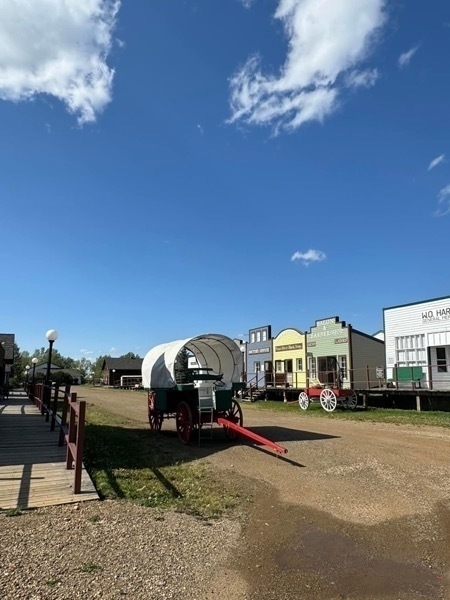
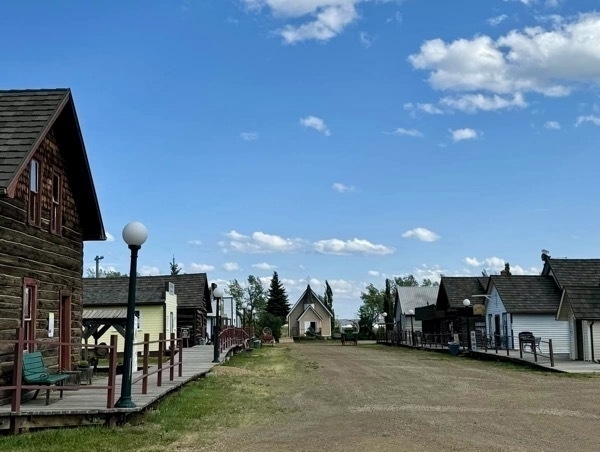
After touring the village together, we drove over the visitor’s center to get a picture by the iconic Alaska Highway sign together
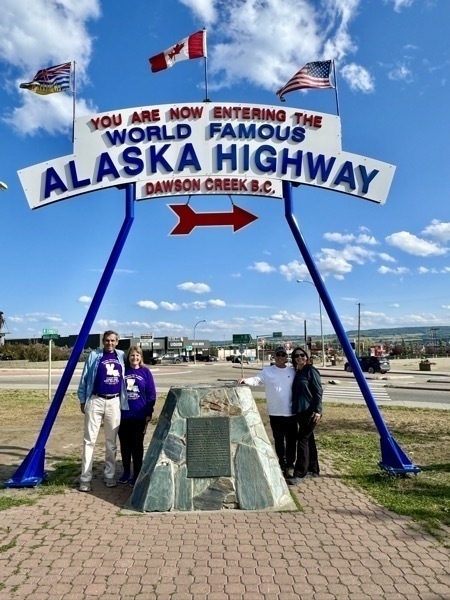
Tom & me with Johnny & Susan Lowry
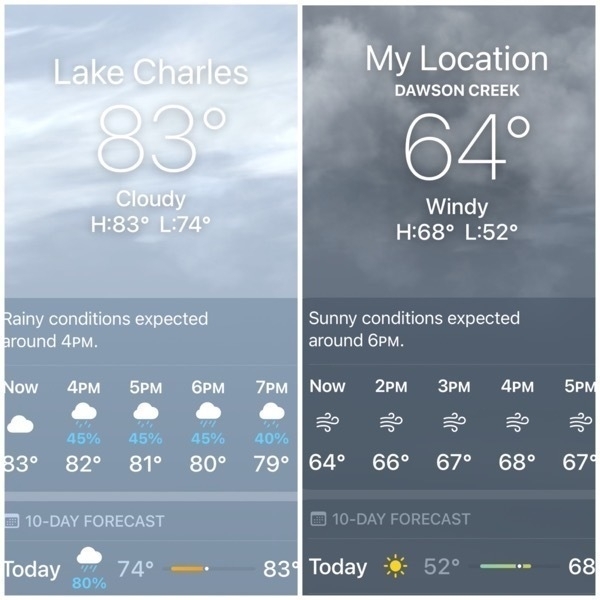
-
Day 28 Alaska Trip - Dawson Creek, BC

Today we entered British Columbia after driving through Ontario, Winnipeg, Saskatchewan, Manitoba
Recycling and deposits in Canada
Recycling is strongly encouraged in Canada. They must pay a 10¢ deposit on every can, water bottle, milk carton, juice box, etc. that is purchased. There are NO plastic bags at the checkouts in the stores. Either you bring your own or pay 25¢ for a paper bag.
Alaska Highway
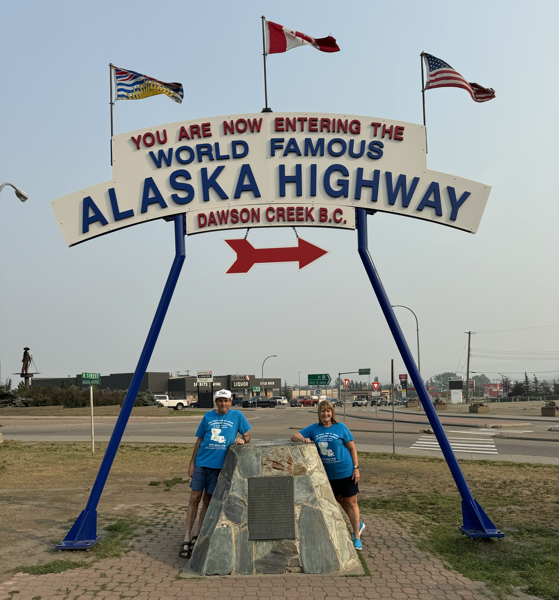
We took this picture today at the famous marker at the beginning of the Alaska Highway.
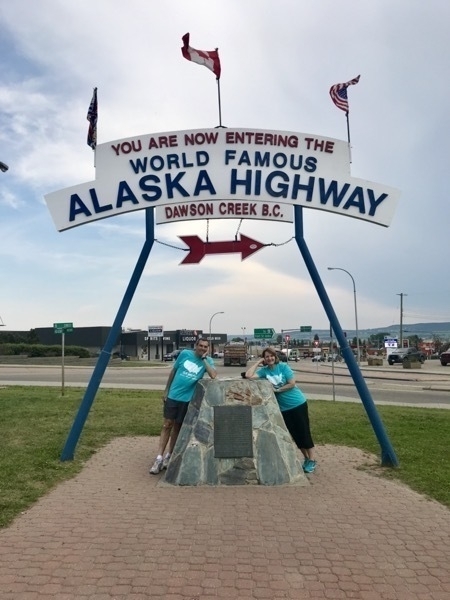
This is a picture of us in 2018 when we drove this trip then.
Alaska Highway
Officially started on March 9, 1942, Army engineers were ordered to construct a road that would proceed in a northwesterly direction from the railhead at Dawson Creek, BC, and connect with the existing Richardson Highway at Delta Junction, AK. A pioneer road was constructed through 1,525 miles of wilderness in 8 months and 12 days. The men worked 16 hours a day in the summer months and survived black flies, gnats and mosquitos and in the winter worked in temperatures as cold as -70. In the winter the heavy equipment took a beating. Harsh temperatures of -70F, froze lubricants, seized transmissions, and snapped axles. Equipment had to be kept running 24 house a day.
Quick Facts
- 11,000 troops
- 16,000 American and Canadian civilians
- 133 bridges constructed
- 7,000 pieces of heavy equipment
- 8,000+ culverts installed
Trip Statistics
- Distance driven in the RV - 142 ,
- Distance driven in car today - 5
- Total Trip distance driven so far 4,012
- Gas today was $4.26 per gallon and we spent $169.44. Total so far is $1,808.55
- We stayed at Mile 0 Park & Campground $34.30
-
Day 27 Alaska Trip - Valleyview, Alberta
We drove 228 miles today from Glowing Embers RV Park in Acheson, AB (outside of Edmonton) to Young’s Point Provincial Park in Valleyview, AB
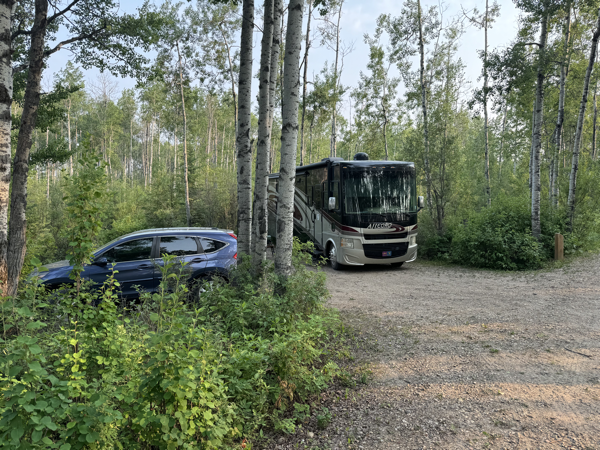
The campsite is big and private but we could not level the motorhome so we spent the night with all the slides still in. Definitely not our favorite way to spend the night, but were still able to cook, shower, and use the AC without a problem.
Trip Statistics
- We stayed at the Young’s Provincial Park Campground for $29.20
- We have driven a total of 3,848 miles in the car and RV
- Groceries and Eating Out have cost us $672.55 for an average of $25.87 per day
- Total spent on gas $1,639 for an average of $63.04 per day
- Gas cost $5.17 a gallon today
-
Day 26 Alaskan Trip - Edmonton again
We drove to the Old Strathcona part of town to catch the historical Edmonton streetcars that took us across the historical High Level Bridge and back.

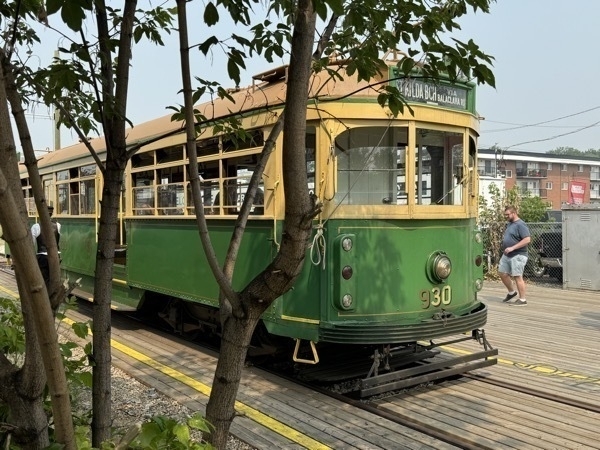
Our morning ride

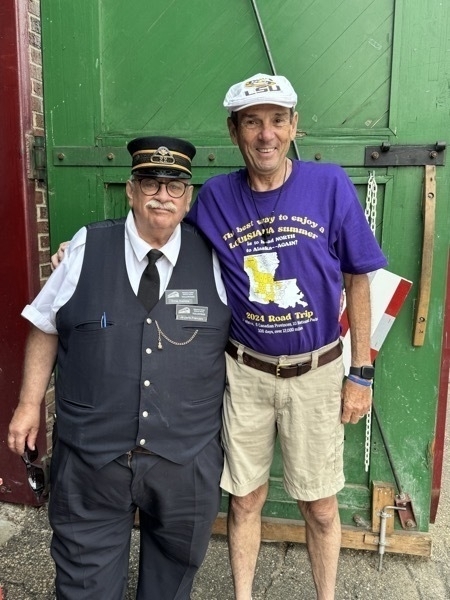
The trolley driver and Tom
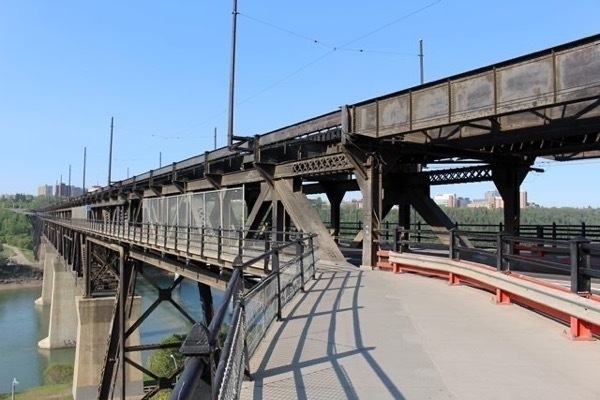
High Level Bridge - built in 1912 to accommodate trains, streetcars, bicycles and automobiles
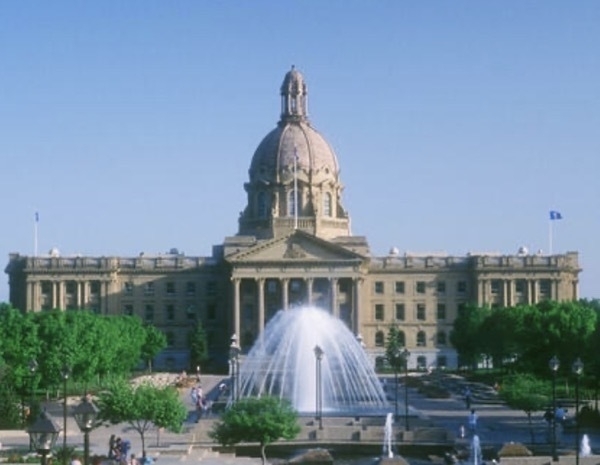
Edmonton Legislature Building
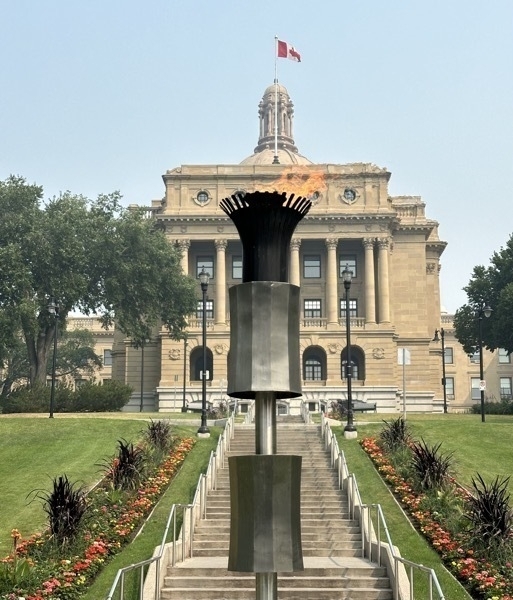
Centennial Eternal Flame

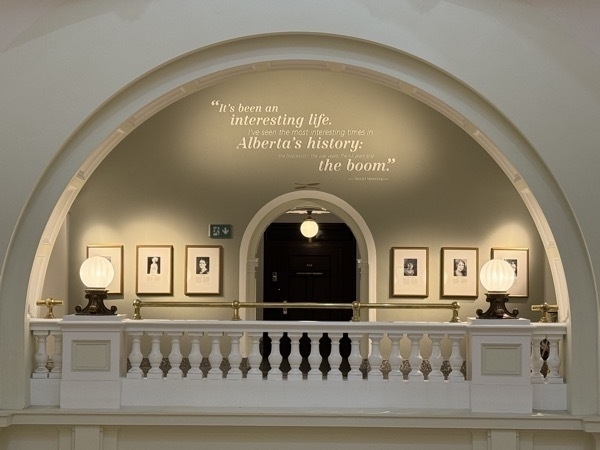
Inside of the Legislature Building—”It’s been an interesting life. I’ve seen the most interesting times in Alberta’s history: the Depression, the war years, the oil years and the boom.” -Muriel Manning
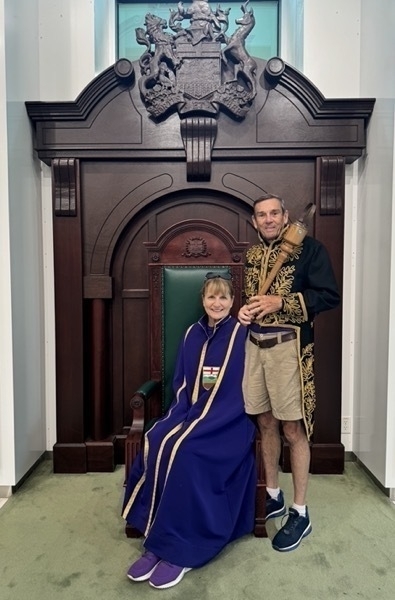
We went to the Legislature Museum and saw a very interesting movie and then had a quick photo shoot in the royal garb.
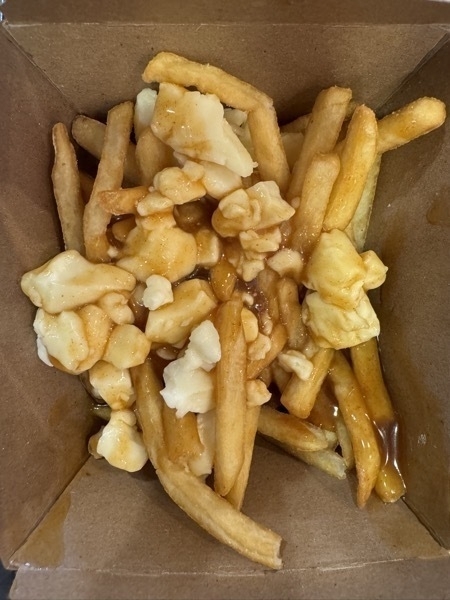
Poutine - very popular in Canada consists of French fries with gravy and cheese curds
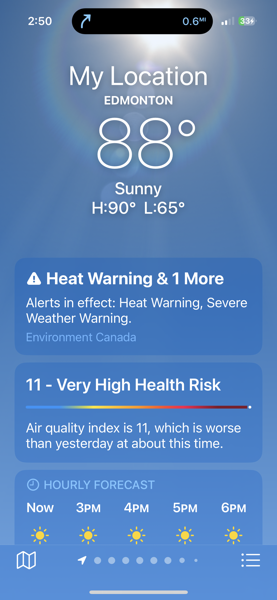
It was hot and humid today but the smog was so bad that all ball games were cancelled. Fort Edmonton, which we had hoped to visit, was closed for the day was also closed. The smog was caused by all the forest in Alberta.
Trip Statistics
- We stayed at the Glowing Embers RV Campground for three nights $42.26 a night
- We have driven a total of 3,640 miles in the car and RV
- Groceries and Eating Out have cost us $672.55 for an average of $25.87 per day
- Total spent on gas $1,574.11 for an average of $60.54 per day
-
Day 24 Alaska Trip -West Edmonton Mall
Royal Alberta Museum
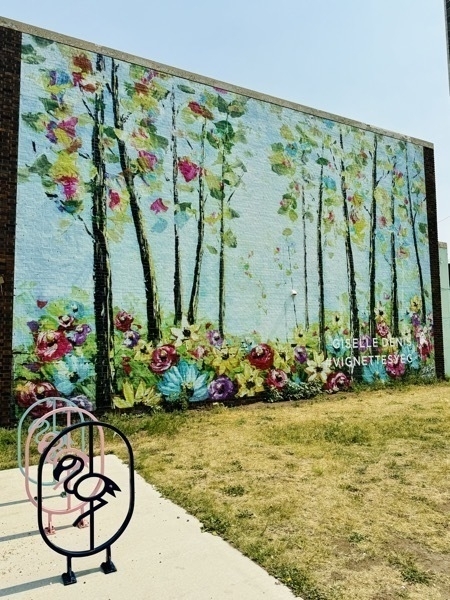
A beautifully painted wall next to where we parked the car to tour the museum. Incidentally, the parking was $15 while the museum entrance fee was $14 per senior.
Royal Alberta Museum
The Royal Alberta Museum had four fascinating sections: the Human History Hall, Natural History Hall, Bug Gallery and a Feature Gallery that showcased artifacts and history from Angkor Wat temple Complex in Cambodia (where I’ve been).
The Angkor Wat Gallery

My picture of Angkor Wat from my visit in 2017. It is considered the world’s largest religious structure in the world. Construction began in in 1129 and completed around 1150. It was dedicated to the Hindu god Vishnu, but was gradually converted to a Buddhist Temple as it remains today.

These artifacts were from recovered and date back to the 1100s.
Hall of Natural History

Hall of Human History
The history of the indigenous people was very interesting. We watched a short video of how they wore a bison costume and lured a herd of bison into corals as pictured below where they could easily kill a huge number.
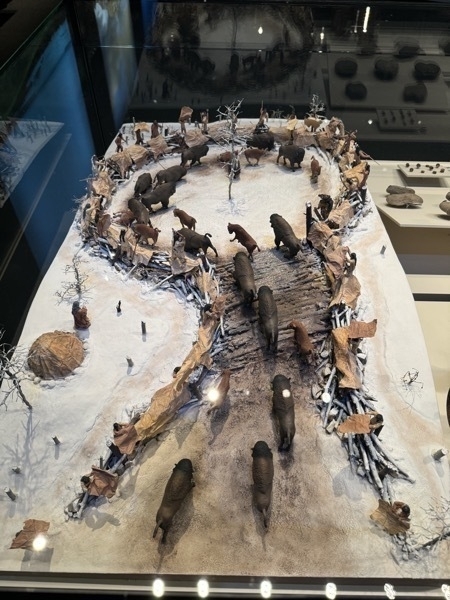

Beads and sicknesses went hand in hand. European traders benefited from immunity to many diseases, but indigenous people had no protection. Recurring epidemics devastated entire nations. Mortality rates sometimes reached 90%. These beads illustrate the virus or bacterium associated with different diseases. Measles, influenza, whooping cough, bubonic plague, cholera, diphtheria , typhoid fever, smallpox, scarlet fever and chickenpox.
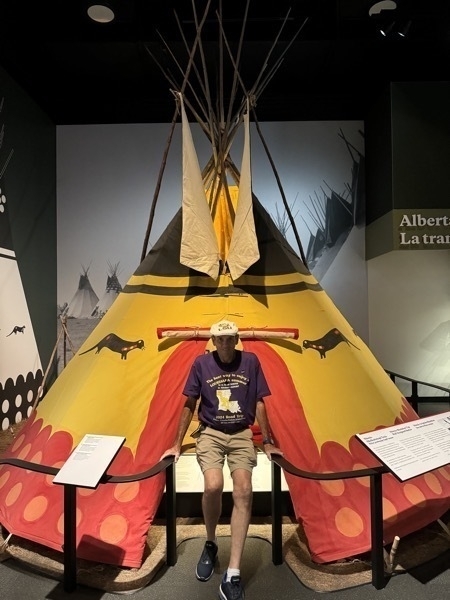
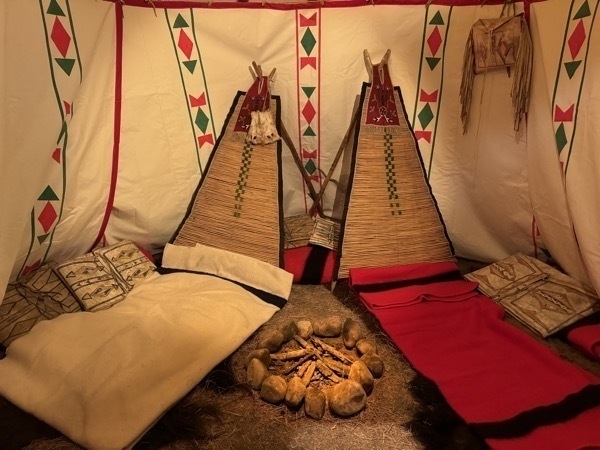
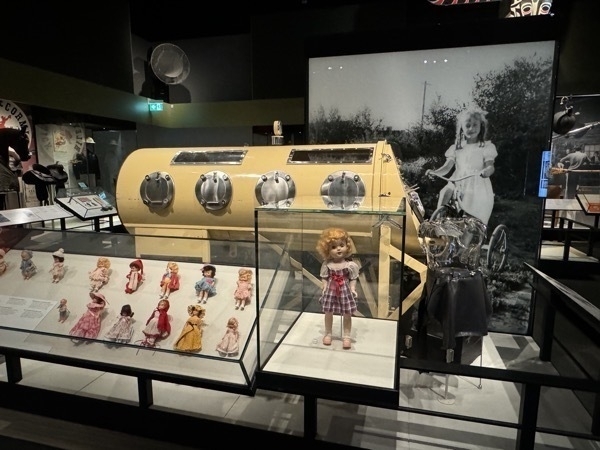
The iron lung from the polio epidemic of the 50’s. The person’s whole body laid inside the machine with only the head propped up on the end.
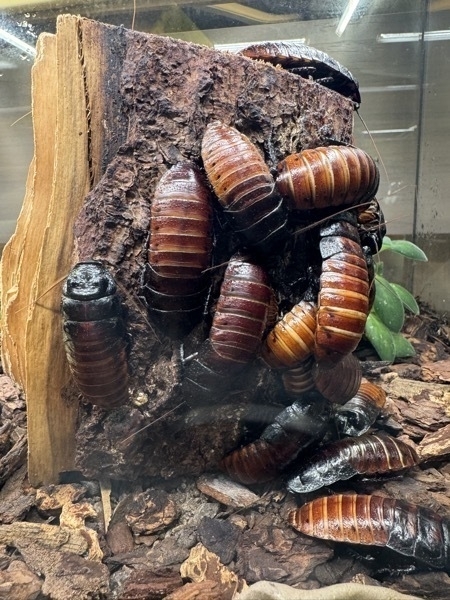
Madagascar hissing cockroach

Mexican redone tarantula
West Edmonton Mall
This is the largest mall in North America. It contains an amusement park, a water park, over 800 stores and restaurants, ice skating/hockey rink, marine life exhibit, bowling alley, escape room and more!
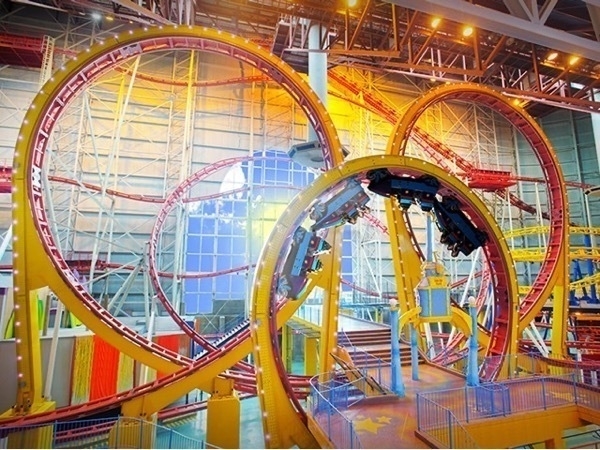
Galaxyland Amusement Park, located in West Edmonton Mall, is the world’s largest indoor amusement park and offers space-themed rides for all ages
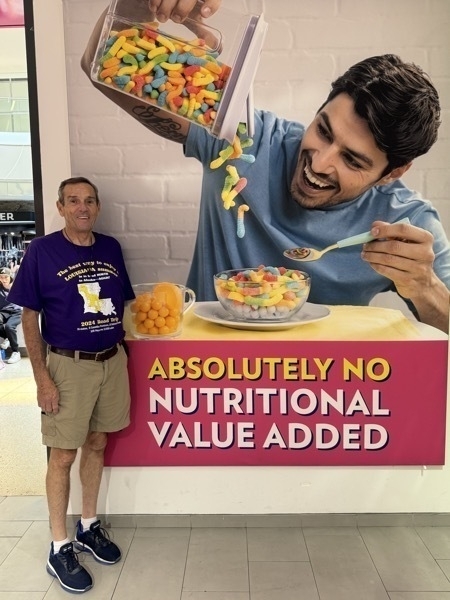
There were several huge candy stores
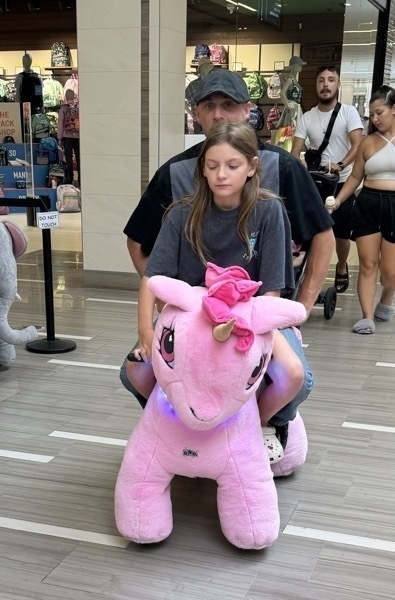
These motorized stuffed animals can be rented and ridden in the mall.

-
Day 23 Alaska Trip -Ukranian Heritage Museum to Edmonton, B
Shortly after leaving Suffern Lake Regional Park Campground and getting back on the highway, we crossed the border into Alberta.
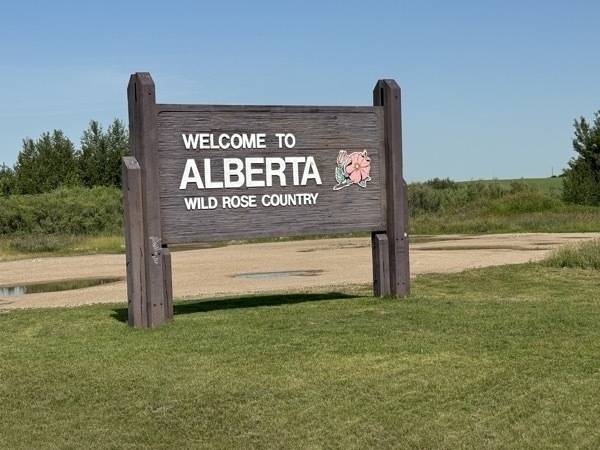
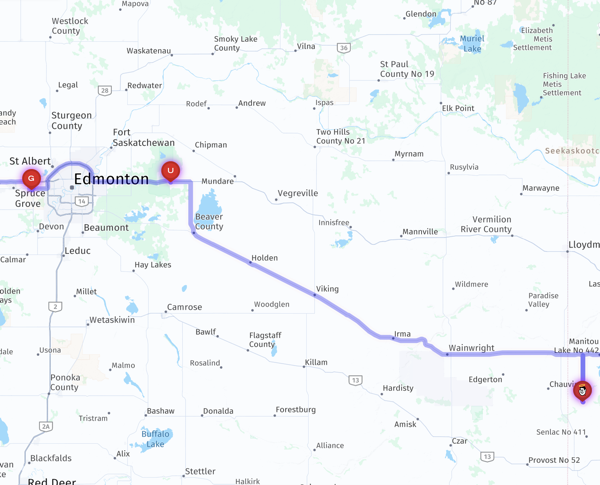
For almost the entire time we’ve been driving we’ve been listening to Greg Iles newest book Southern Man. The book was 45 hours and 44 minutes long and could have easily been half that length. I checked on maps to see how many hours it would take to drive straight home from the point we finished the book and the answer was 34 hours (of course we didn’t come here straight from home, but I was curious. We had driven over 56 hours at that point). Listening to books over Apple Play is always a good way to pass the time. Some are better than others.

Uranian Cultural Heritage Village
The Ukrainian Cultural Heritage Village Society purchased the present site and began relocating buildings from farms and towns of east central Alberta. Since the beginning more than 40 buildings have been moved to UCHV where they have been researched, restored and furnished to their early 20th century appearance. The village used a technique known as first-person interpretation which requires that the costumed performers remain in character al all times. Actors answer all questions as iff it is the year their building portrays.
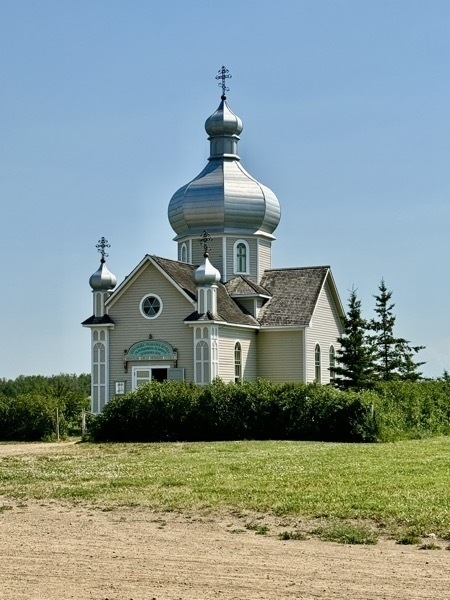
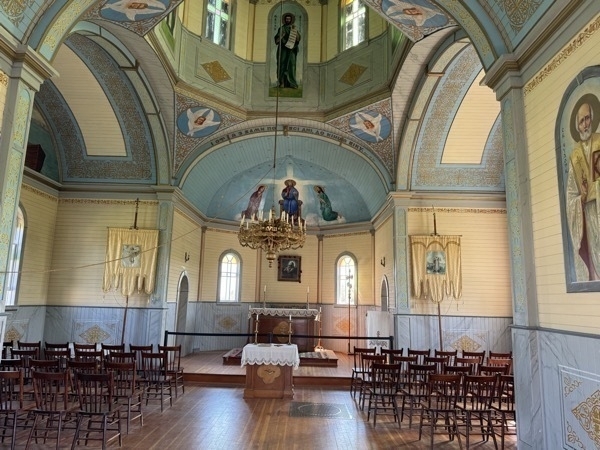
The outside and inside of the St. Vladimir’s Greek Orthodox Church, built in 1934
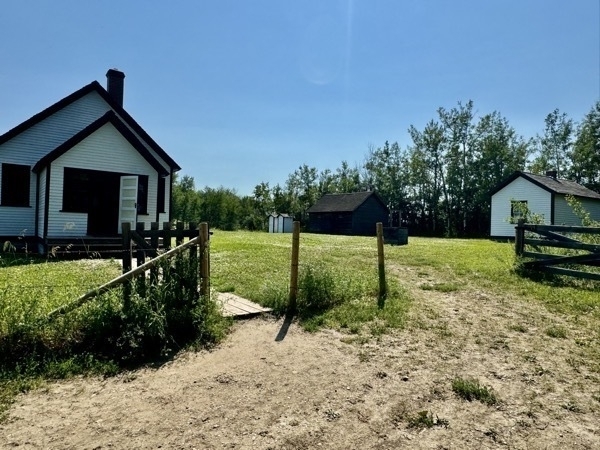
The old school house on left, girls and boys outhouses in back, the barn for the horses some students rode to school and the Teacher Shack. This was built in 1910.
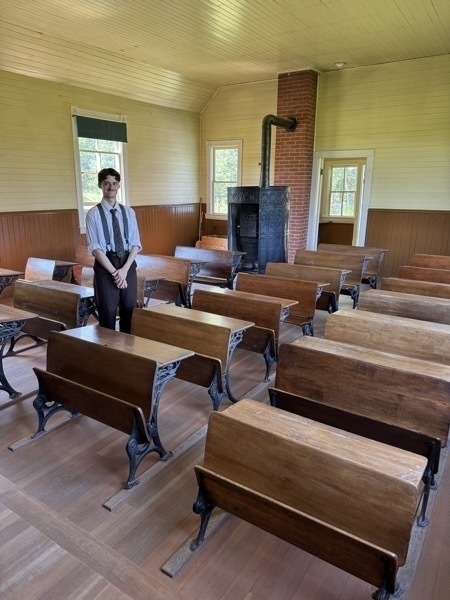
The inside of the one-room schoolhouse

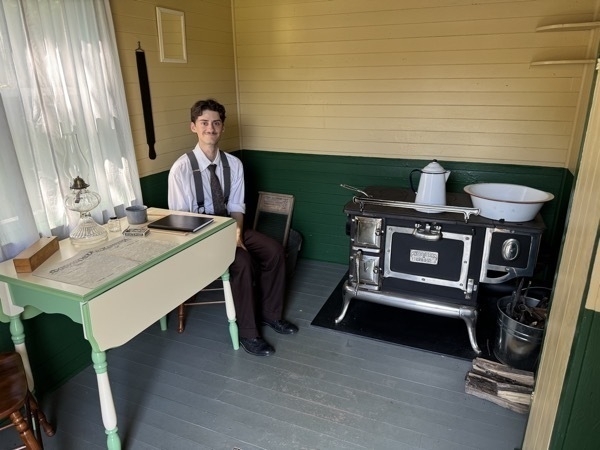
The “Teacher’s Shack” complete with a bedroom and a kitchen. Built in 1927.
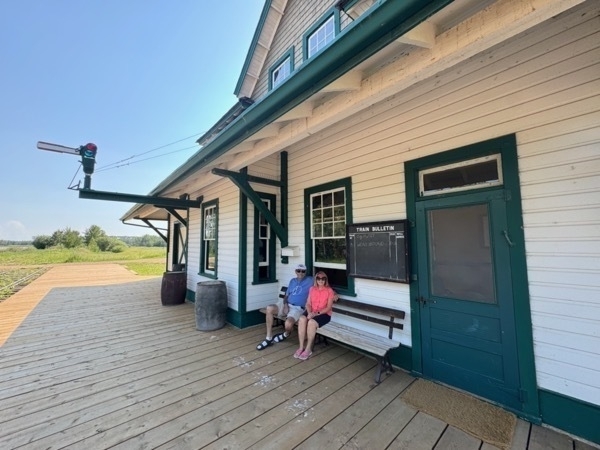
Railway Station
After spending around two hours at the Village we drove our final 51 miles to the Glowing Ember Campground west of Edmonton, Alberta, Site 319.. The first evening in Edmonton was the hottest weather they’d had in 40 years. It was 92 and felt like 96. I looked at the weather at home in Lake Charles and it was actually warmer here.
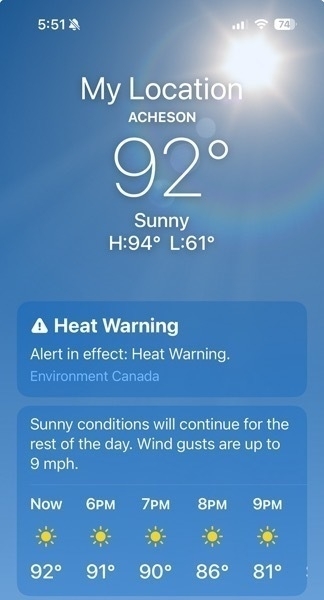
Sunset is 10:15PM and sunrise is 5:34AM
Trip Statistics:
- Miles driven in motorhome today -213
- Miles driven in car 0
- Total driven in RV and car - 3,525
- Camping at Glowing Embers Campground in Acheson (west of Edmonton) - $42.26 (Trip average of $36.25 per night)
- Groceries, Earring Out and Snack have averaged $26.90 per day
- Gas has cost $1,583.62 for both vehicles or and average of 63.34 per day —.45 per mile
-
Day 22 Alaska Trip-Saskatoon to Suffern Lake
We spent the day driving 174 miles across Saskatchewan from Saskatoon to a stop in the middle of nowhere. The only highlight of the day was briefly being behind a truck moving a two-story house down the road, but we were able to pass fairly quickly.
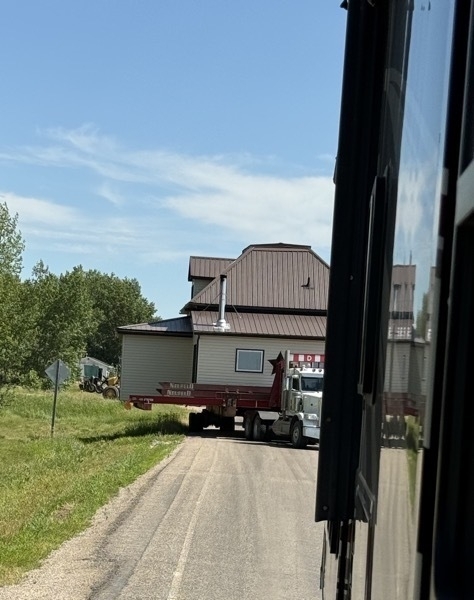
We stayed at the Suffern Lake Regional Campground which was an unfortunate choice because it was 10 miles off the highway, five of that was on gravel. The campground itself had a nice playground, a lake with a small sandy beach and a small golf course-like area, but the spot assigned to us was very hilly and would have been impossible to level. We requested a different site and were given our choice at a slightly different location where we were the ONLY ones camping! The mosquitos were horrible.
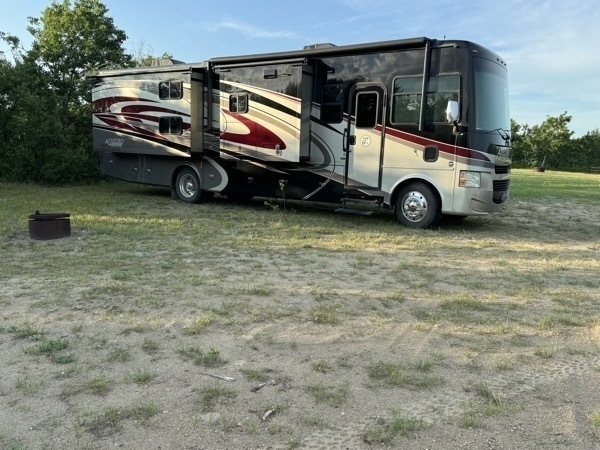
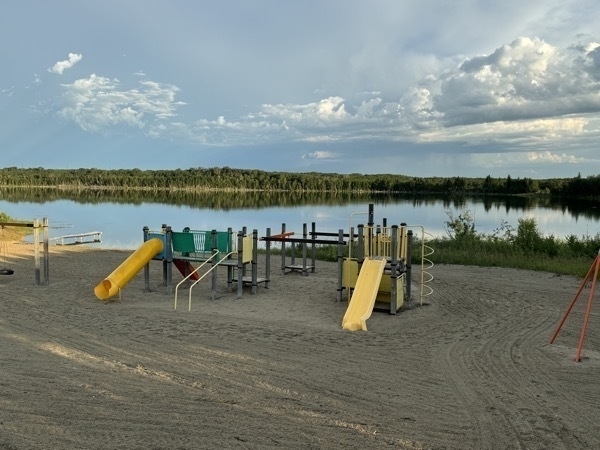
-
Days 20 & 21 Alaska Trip - Saskatoon, Saskatchewan
We are now 21 days into our journey to Alaska and have been enjoying magnificent weather. After driving only 51 miles from our previous campground, we arrived in Saskatoon, Saskatchewan.
Our water pump stopped working a few days ago so we contacted a mobile repairman to fix it. We waited all afternoon at our campsite, but he never arrived. The water in our motorhome works fine as long as we are connected to the campsite’s water supply. We finally gave up on the repairman and decided to tour Saskatoon today.
Saskatoon Forestry Farm
We started the day by touring the Saskatoon Forestry Farm that houses a wide variety of animals from bears and mountain goats to tiny bald rats and poisonous green and blue frogs.

Prairie Dogs

White wolf
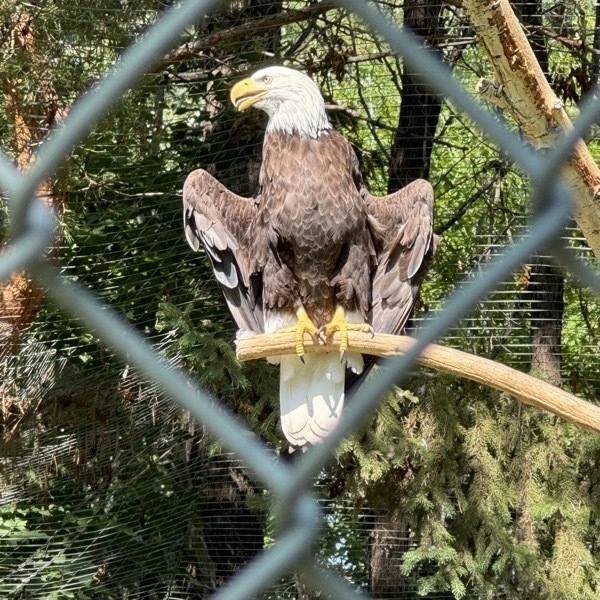
Bald Eagle
Western Development Museum
This museum was a very interesting step into history. Here’s a few of the displays.

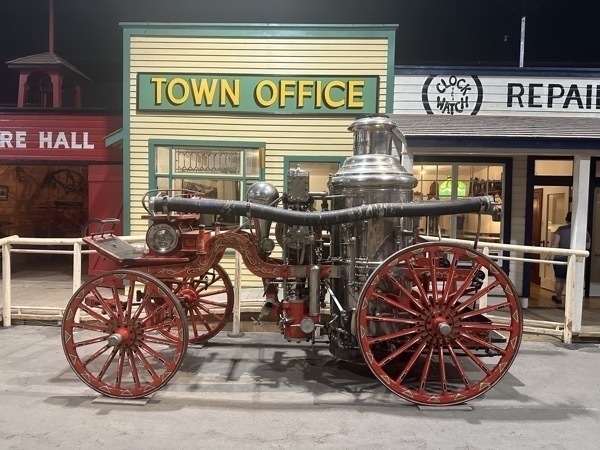
The pump truck used by the fire department

From the sign by the exhibit: (replica of a house built in 1904)
On the treeless prairie, thousands of homesteaders built their first homes from the ground beneath their feet - prairie sod.
Sod slab by sod slab, grass side down, walls grew out of the prairie. Once the walls were up, roof rafters were fashioned from poplar or willow poles, then covered with a layer of hay or tar paper and topped off with sod.
Doors and windows were often the only purchased materials in the entire construction.
Inside, bare walls were sometimes wallpapered with newspaper and dirt floors were covered with throw rugs. Packing cases might serve as chairs, linen-closets and china cupboards.
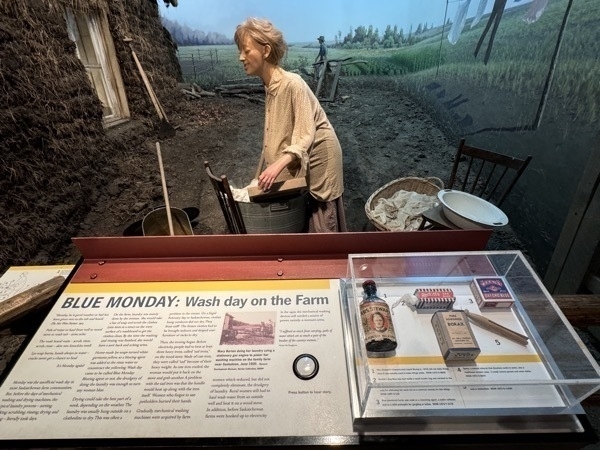
On Sunday night the wash broiler was filled with water and placed on the kitchen stove so that it would heat up first thing Monday morning when the fire was started. Bars of home-made lye soap like these were shaved into the boiler to melt into the water as it was heated on the stove. The soap was made from animal fat and lye, a strong alkali made from wood ash and bones.. A paddle or a stick, often the cut-off handle of an old broom, was used to stir the washing in the boiling-hot water.
Washing usually required a variety of tubs–3 basins and pans such as these. In summer, tubs and basins were set on benches or kitchen chairs in the farm yard. Clothes were scrubbed clean in tubs of warm, sudsy water.
Wet laundry, from fine linens to heavy overalls, was wrung out by hand.
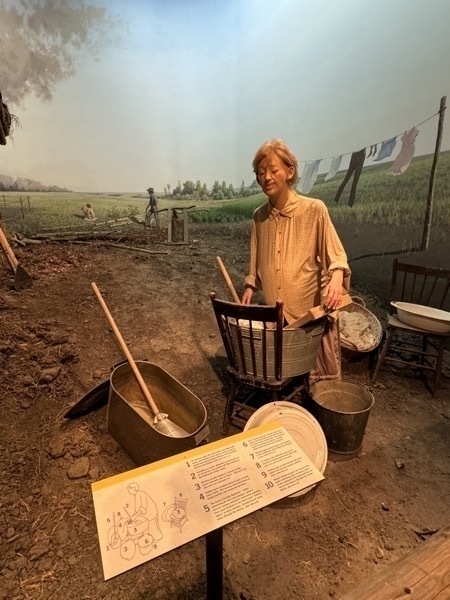
“No Severe Exertion Required.” 1920s advertising for this hand plunger, called a vacuum washer, claimed it could wash anything from horse blankets to the finest laces “without injury in three minutes. Suction forced soapy water through the fabrics.

An earlier version of today’s campers pulled behind cars. This one was used in 1931.
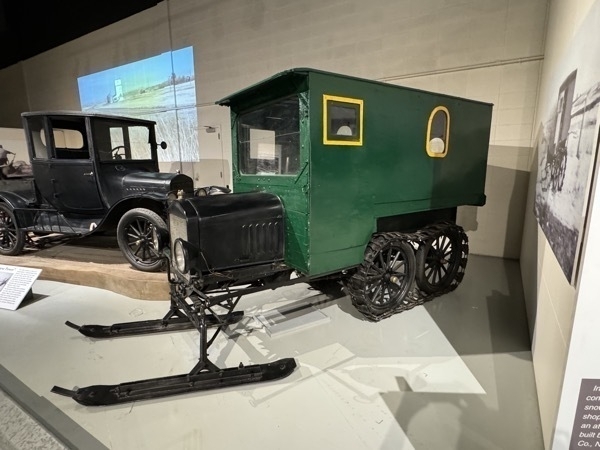
In Canada and the northern United States, mechanics converted Model Ts into snowmobiles for winter travel. Rural delivery services and doctors, in particular, fitted their Model Ts with skis to cover their large territories.
Doctors had to travel far and wide no matter the weather. In 1927, Dr. Johns asked the mechanic at Block’s Garage in Viscount to convert this Model T for winter travel. On his way to deliver a baby near Plunkett, Dr. Johns’s snowmobile ran out of engine oil so he topped it up with water. He got there in time but his snowmobile was ruined.
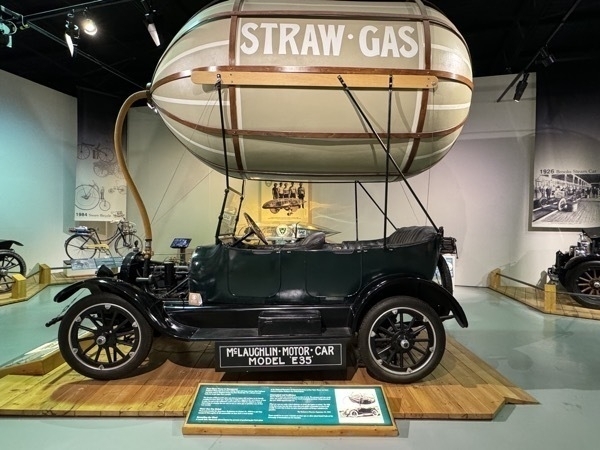
Straw gas powered car
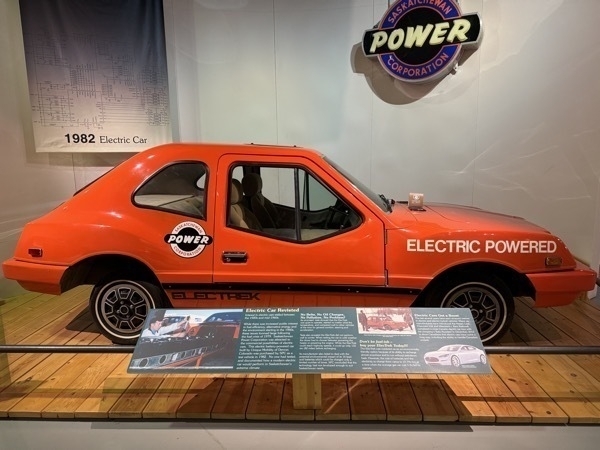
Now that electric cars are increasing in popularity, here’s one that was developed in 1982. The ElecTrek was marketed as an environmentally friendly option because of its ability to recharge almost anywhere and to run without petroleum fuels. However, the cost of batteries and the electricity to charge them came to 10.79 cents per km at a time when the average gas car cost 5.2 cents per km to operate.

A nice painting on the side of a building in downtown Saskatoon

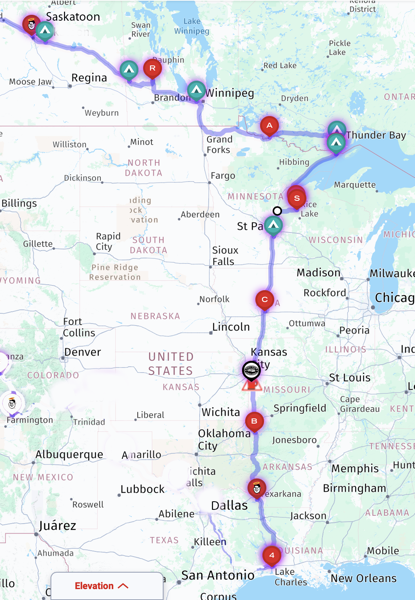
Here is the map of our trip to this point
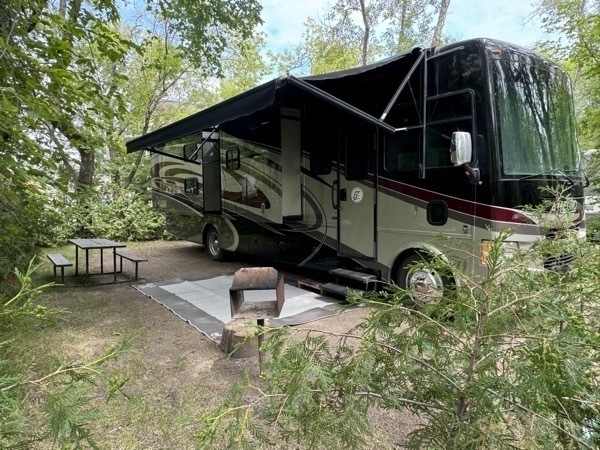
Site 46 at the Gordie Howe Campground
TRIP STATISTICS:
- Miles driven in the RV yesterday :51
- Miles driven in the car 36
- Total miles driven in car and RV: 3,135
- Gordie Howe Campground $37.50 per night. The average cost has been 36.22 per night
- Groceries and food: $522.03 for an average of $24.86 per day
- Last gas cost $3.978 a gallon . Our total is now $1,198.48 which has averaged $57.07 per day
-
Day 19 - Middle of Nowhere Manitoba
We are heading towards Saskatoon, but spent the night in the middle of nowhere ( actually Colnsay No. 342) at the Painted Rocks Campground
Once again, our views included miles and miles of beautiful fields of canola flowers, a few trains and some silos for storage.
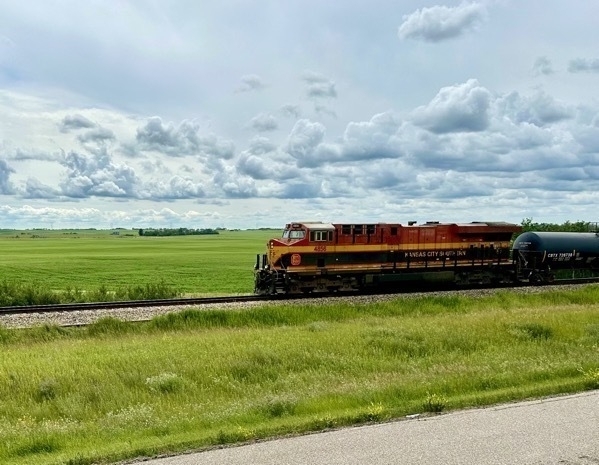

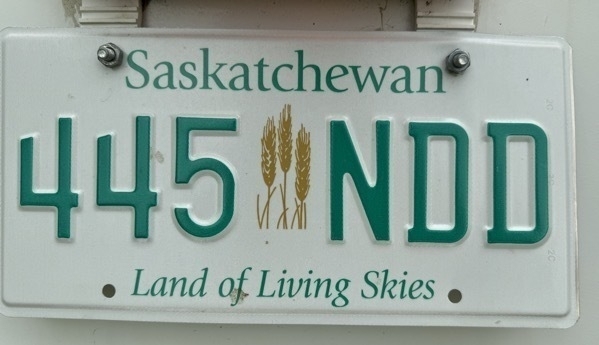

These plastic shelters are also known as bee condos or bee houses that provide nesting spaces for alfalfa leaf-cutter bees and are seen in Saskatchewan. These bees act as tiny farmhands-pollinating crops such as alfalfa or hybrid canola.
Canola Fields
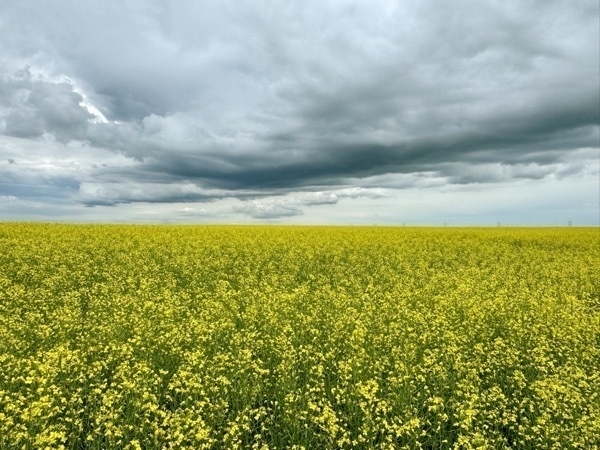
Saskatchewan is renowned for its vast canola fields. Canola is one of the primary crops grown in Saskatchewan and is used to manufacture canola oil. Canola is a major export commodity . The province exports large quantities of canola oil and see to international markets, including the USA, China, Japan and the European Union. Canola is also used in the production of biodiesel.
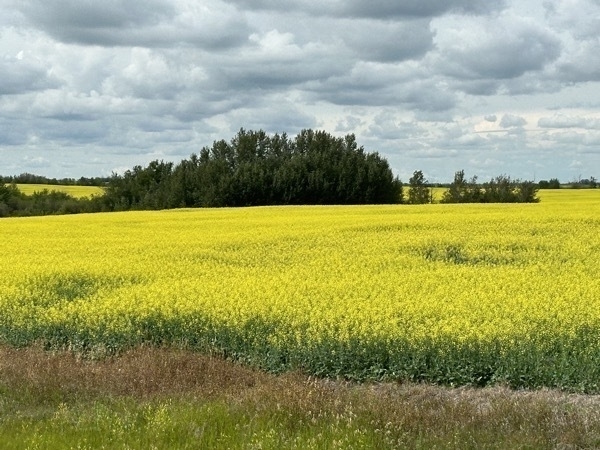
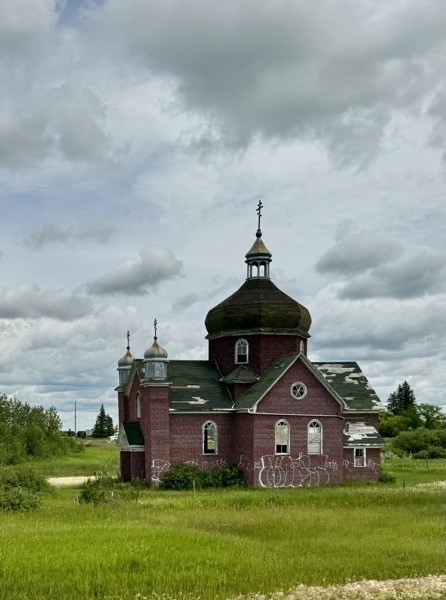
The remains of an old Ukrainian Church
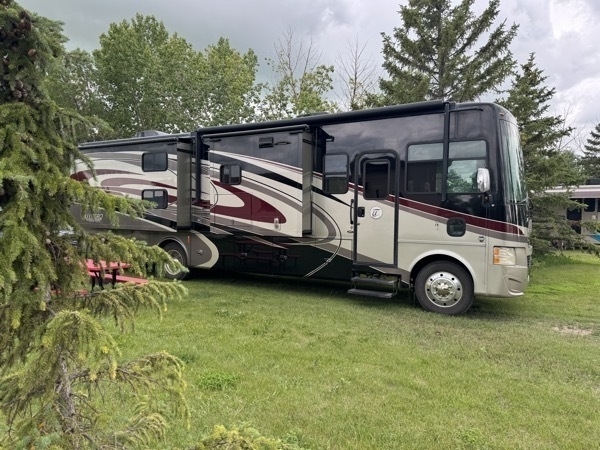
We stayed at the Painted Rocks RV Campground in site #5
TRIP STATISTICS:
- Miles driven in the RV today :247
- Total miles driven in car and RV: 3.048
- Painted Rock RV Campground $27.78. The average cost has been 36.08 per night
- Groceries and food: $433.78 for an average of $22.83 per day
- Last gas cost $3.978 a gallon . Our total is now $1,198.48 which has averaged $63.08 per day. Today’s average is .393 a mile
-
Day 18 Alaska Trip - Binscarth Park and Pool Campground, Manitoba
Binscarth, Manitoba
The whole day was spent driving across the prairie lands in a very rural section of Manitoba. We saw many beautiful canola fields which helped break the monotony, but other than those and an occasional passing train, there wasn’t much to see.
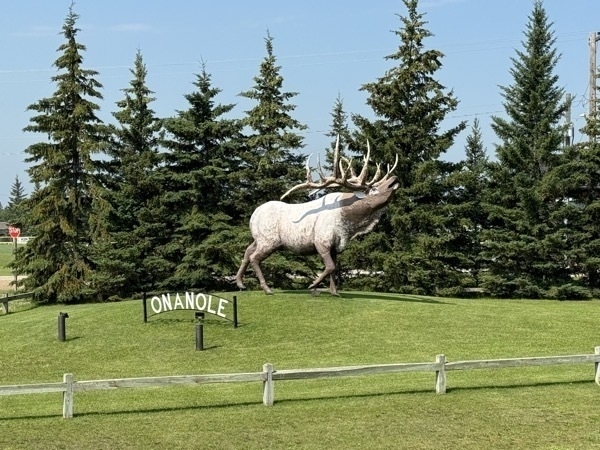
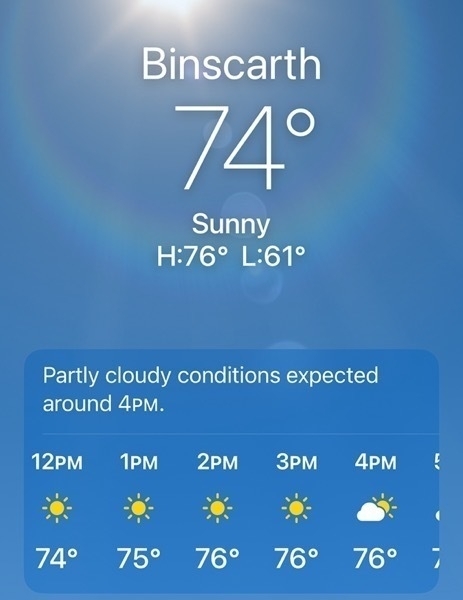
The weather is beautiful up here!

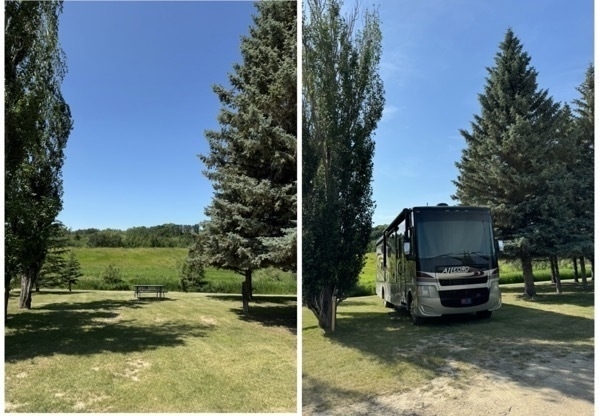
We stayed at the Binscarth Pool and Campground and our space looked very promising until I backed into the site. No matter which position I put the motorhome, it was still going downhill in the back. We tried placing blocks under the levelers to no avail. Finally gave us and just kept all the slides pulled in. Wasn’t bad though—our first motorhome was only this wide to start with and had no slides.
-
Day 17 Alaska Trip - Riding Mountain National Park
Today’s destination was Riding Mountain National Park in western Manitoba. The wildlife of Riding Mountain National Park is supposed to be unparalleled according to the brochures. Parks Canada estimates there are 800-1,000 black bears, 3,000 moose and 40 plains bison in the park.
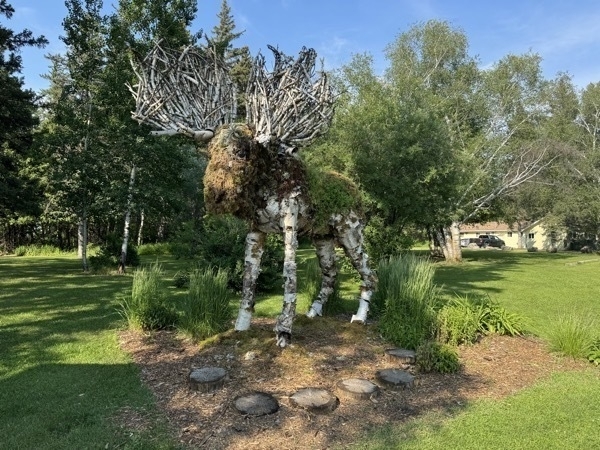
The first and only moose we saw in the park
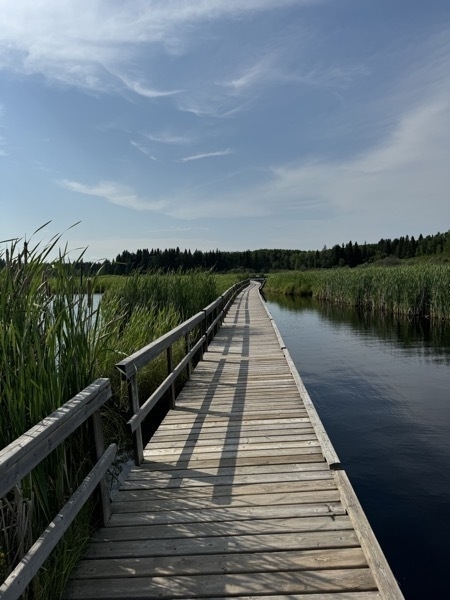
We walked on this floating boardwalk around the lake and were surprised to see a family of swans.
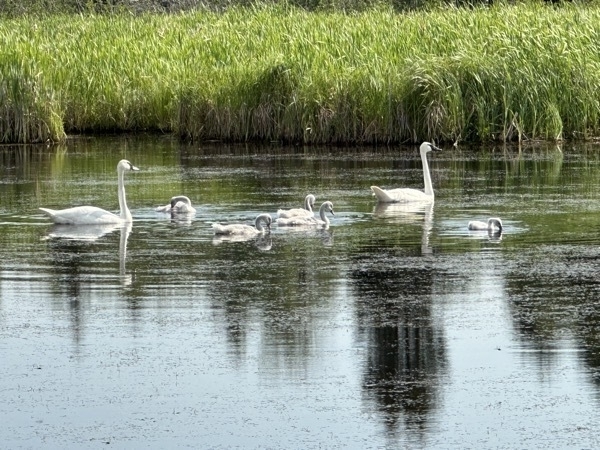
After dinner we drove to another lake to try to see some other wildlife. Tom spotted a bear right outside of our campground area and then we spotted another a few mile up the road.
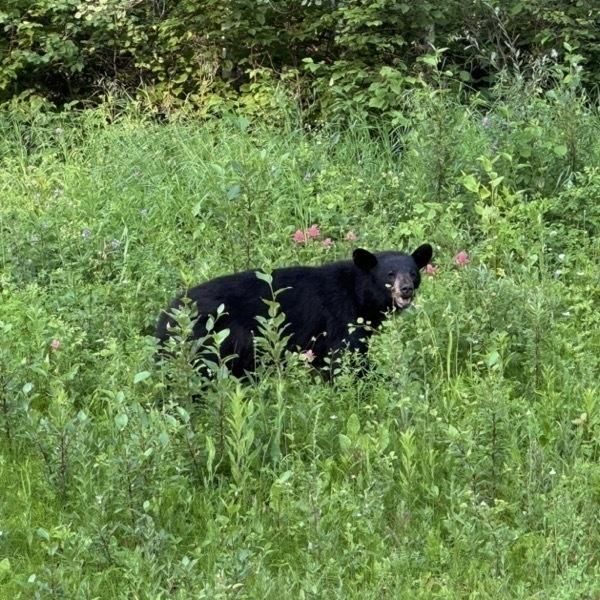
Notice that this bear gave himself a little blonde streak on his nose1
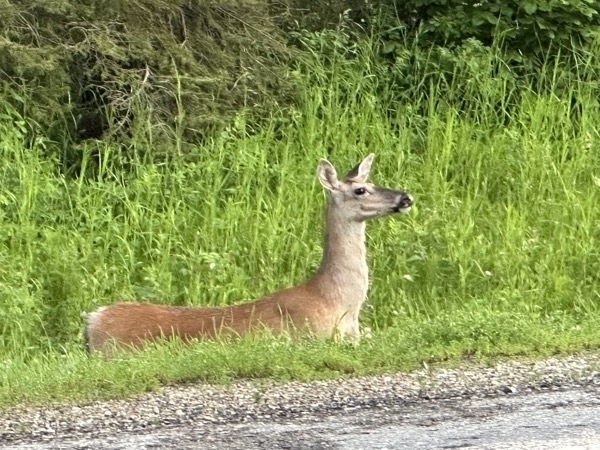
It’s not unusual to see a deer, but this one was just eating grass on the side of the road rather than trying to dart across the road.
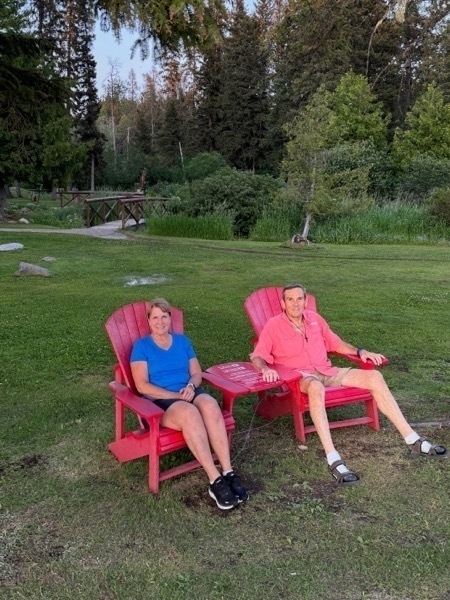
The Canadian National Parks places a set of these red Adirondack chairs in several locations in each of their parks to encouraging taking and sharing your picture at that location. We sat in these as we enjoyed the beautiful sunset over Lake Clear.


Our ride today across Manitoba was 150 miles.
TRIP STATISTICS:
- Miles driven in RV from last stop: 151
- Miles driven car today: 42
- Total miles driven in car and RV: 2,716
- Wasagaming Campground in Riding Mountain NP 31.23
- Groceries and food: $423.43 for an average of $24.97 per day
- Last gas was $3.956 a gallon and we filled up the car and RV for 187.94, and average of $62.63 per day
-
Day 16 Alaska Trip - Manitoba
We had a lazy morning at the camper waiting for two loads of laundry to wash and dry which cost $11.00.
In the afternoon we drove to the ROYAL AVIATION MUSEUM OF WESTERN CANADA where we learned about the people and planes of western Canada’s aviation’s history.
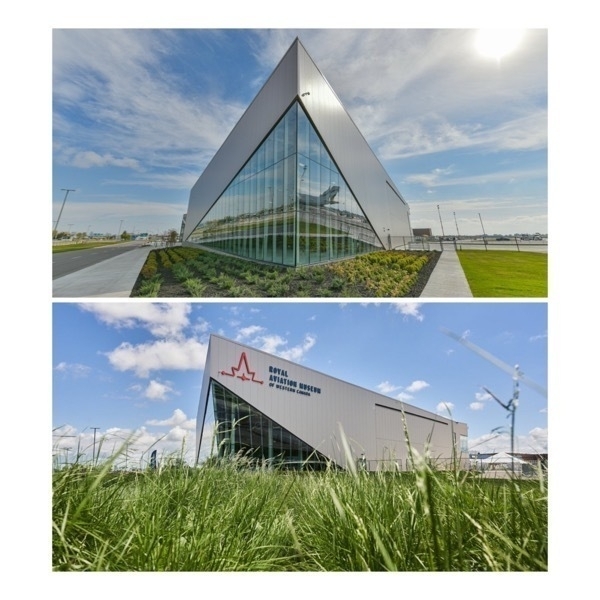

Signs of the Times

These children were forced to attend school away from their parents. Can you imagine what their life was like?

It was a very interesting visit to not only see the various aircraft, but to read all the signs that told about the history of such a rural population.
Fort Wythe Alive
Our next stop was at Fort Wythe Alive. It is a HUGE nature area with walking trails, bison and lakes. We walked the trail to the bison trail and back, but the entire area is flat and not the most interesting for hiking.
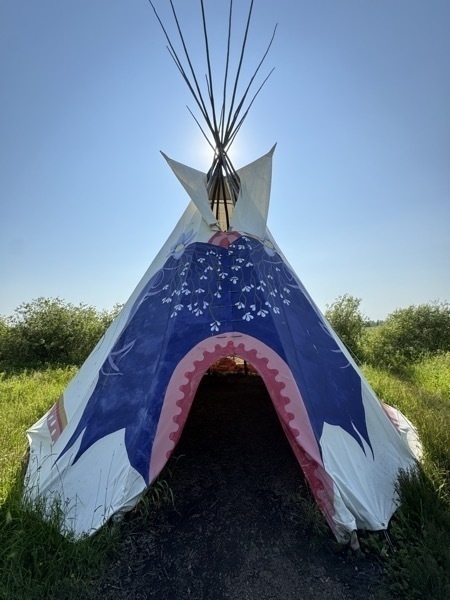
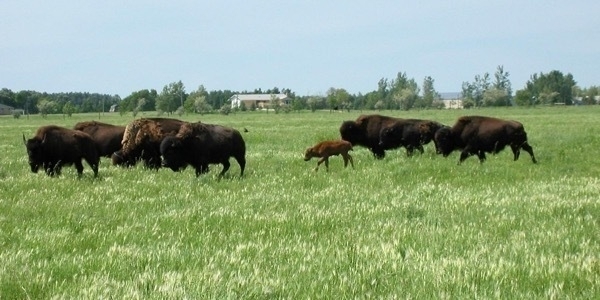
-
Day 15 Alaska Trip - Mannitoba's Mint and Legislature Building
Royal Canadian Mint
Our day started with a fascinating tour of the Royal Canadian Mint. There are only two mints in Canada and only the one in Winnipeg produces the coins that are in circulation. In 1968 the Royal Canadian Mint in Ottawa couldn’t keep up with the demand for circulated coins. The Winnipeg Mint was opened in 1976 and has produced coins in circulation for 77 countries. They also produce some the blanks for the mints in the USA, but never actually prioduce US coins. The mints in the USA, on the other hand, only print coins and currency for the United States.
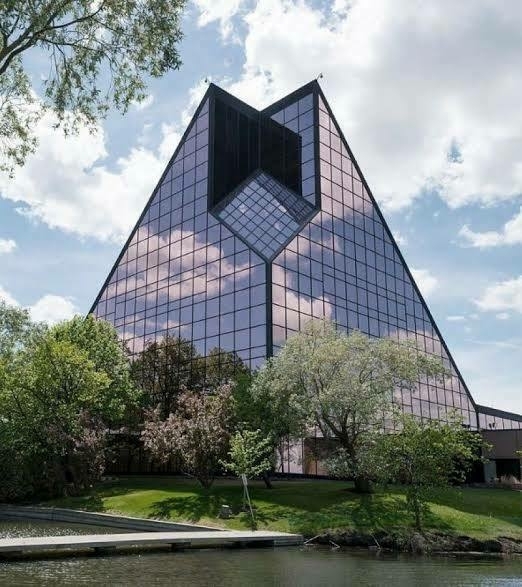
In 1908 - the first Canadian coin minted was the 50 cent piece
1984 - the last circulated coins were minted in Ottawa
1987 - the last $1.00 note is printed and replaced by the $1.00 coin named the “loonie.”
1996 - the $2.00 note was replaced by the $2.00 coin called the “tooie” - a coin made from two different metals.
2004 - the Mint becomes the first in the world to produce a colored circulation coin with the popular red Poppy coin.
2012- the last Canadian one-cent circulation coin is stuck. Distribution of Canada’s penny ends February 4, 2013.
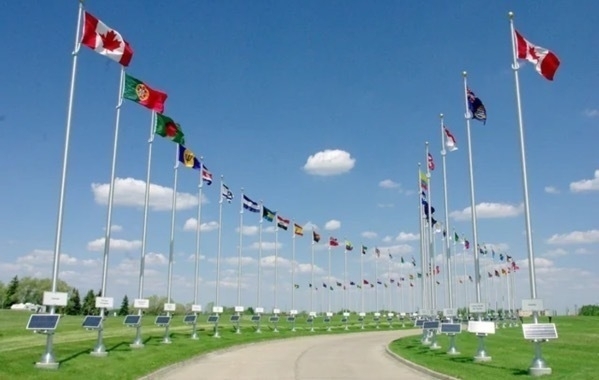
This parade of flags is in honor of the Royal Canadian Mint’s many international customers.

Canadian colored coins in circulation

In 2017 the first glow-in-the-dark coin was entered into circulation, The CA $2 “toonie” features a view of the blue-green aurora borealis above two canoeists paddling along a tree-lined lake. In the dark, the special ink used to produce the image illuminates the northern lights.

New coins minted in 2024 featuring King Charles.
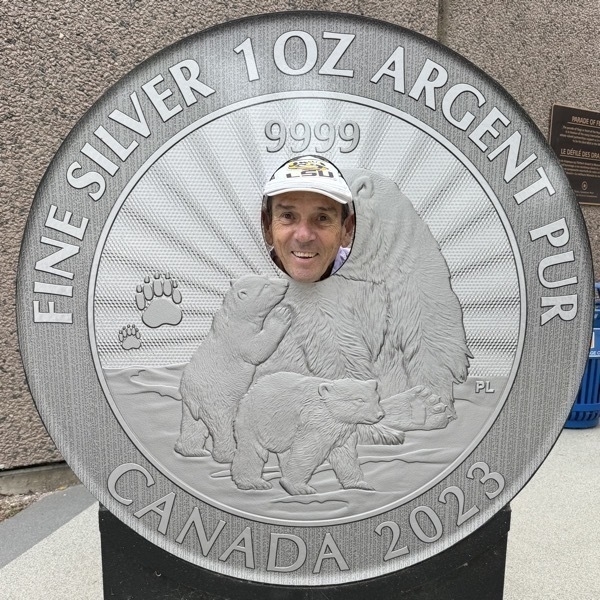
The newest coin - the Tom Hatfield Canadian Loonie!
Manitoba Legislature Building
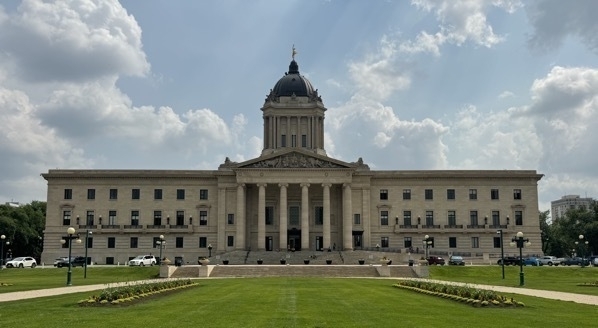
TRIP STATISTICS:
- Miles driven in the car today: 58
- Total miles driven in car and RV: 2,467
- Winnipeg West KOA Campground $43.91. The average cost has been 39.66 per night.
- Groceries and food: $339.37 for an average of $25.96 per day
- Last gas cost $3.14 a gallon . Our total is now $878.74 which has averaged $58.46 per day. Today’s average is .36 a mile
-
Day 14 Alaska Trip - Manitoba Human Rights Museum and Manitoba Museum
We purchased a Winnipeg Attractions Pass and used it today to see some amazing attractions. The first was the Canadian Museum for Human Rights
.
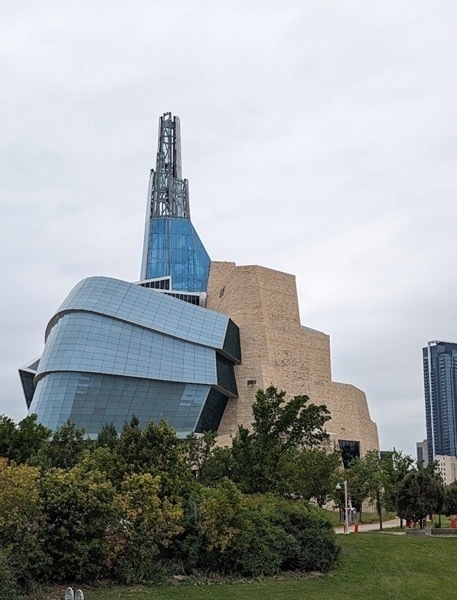
It was opened in 2014 and is the first museum in the world solely dedicated to human rights. The museum features exhibits on various human rights issues, historical events, the stories of individuals and communities who have fought for human rights.
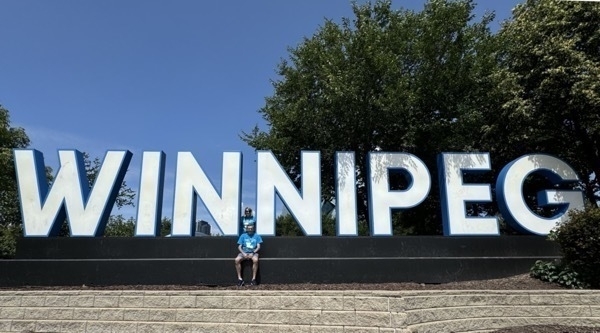
Where in the world are Tom and Mary??? In the middle of Winnipeg!
Winnipeg Museum
Next, we went to the Winnipeg Museum which features the natural and human history of Manitoba and exhibits on the province’s environment, cultures, and history. The dioramas are very detailed and depict life-sized glimpses into life in earlier times
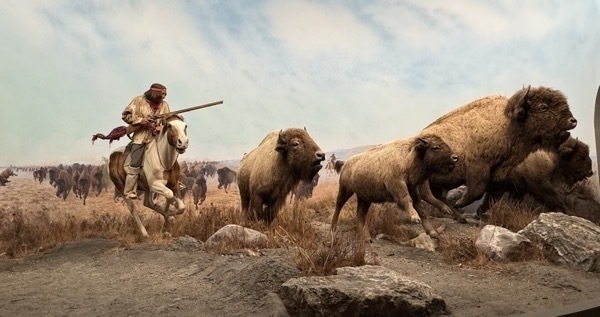
The buffalo are depicted in mid-motion, capturing the energy and movement of the herd.
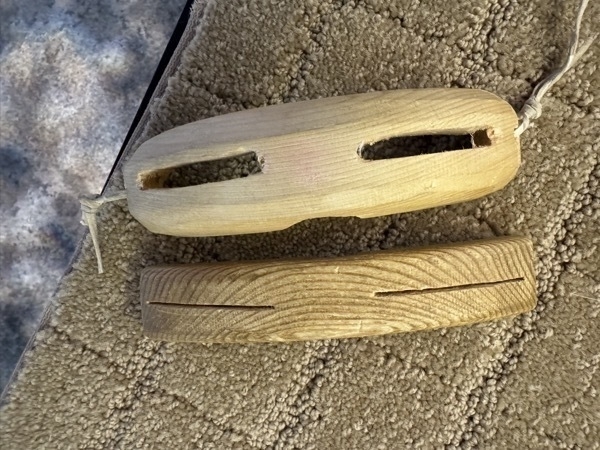
Carved sunglasses crafted by the Intuit people. These sunglasses, made from materials such as bone, wood or antlers and were designed to protect the wearer’s eyes from the intense glare of sunlight reflecting off snow and ice.
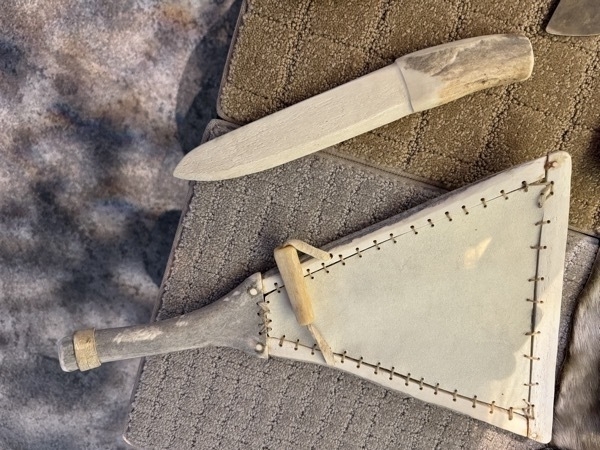
Ice knife traditionally made from bone for cutting snow and a snow scoop designed for moving snow efficiently. These two tools were used to build igloos.

This Arctic diorama depicts an adult male polar bear with a half grown ringed seal that he has dragged onto the ice pack. He is about to enjoy his high energy-packed meal.
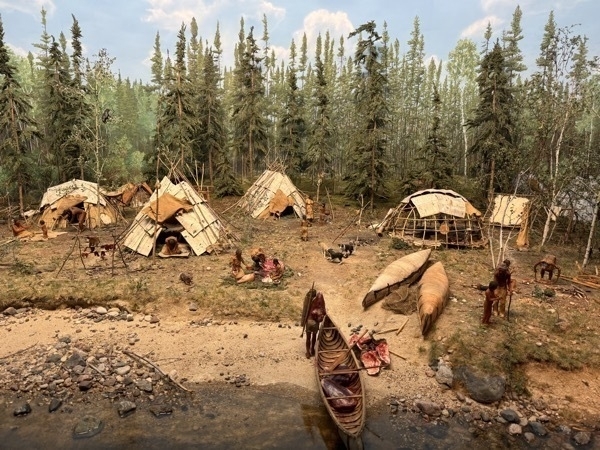
This diorama depicts the daily life of the Intuit people showing their tents (lupiqs) and other structures that illustrate the types of dwellings used by the Inuit in different seasons and tools used in daily life.

This is a full-size replica on the “Nonsuch,” a historic ship that played a pivotal role in the fur trade and the establishment of Hudson’t Bay Company in it’s 1868-69voyage.This replica was built in 1969 to commemorate the 300th anniversary of the original voyage.
After touring the museum we watched a presentation at the Planetarium and then walked around the Children’s Museum..

Check out this giant version of a Lite Brite!
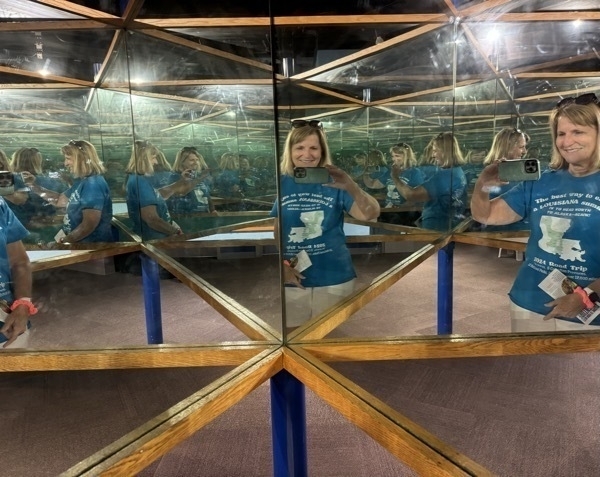
I ducked inside a huge kaleidoscope!
TRIP STATISTICS:
- Miles driven in the car today: 58
- Total miles driven in car and RV: 2,409
- Winnipeg West KOA Campground $43.91. The average cost has been 39.66 per night.
- Groceries and food: $339.37 for an average of $25.96 per day
- Last gas cost $3.14 a gallon . Our total is now $878.74 which has averaged $58.46 per day. Today’s average is .36 a mile
-
Day 13 Alaska Trip -Steinbach, Manitoba
Today we drove from International Falls, MN and stopped in Steinbach, Manitoba to visit the Mennonite Heritage Village.
The village has both an indoor museum and an outdoor open-air museum which displays original buildings that are significant to Mennonite history. These included traditional Mennonite houses, barns, schools, and church buildings.

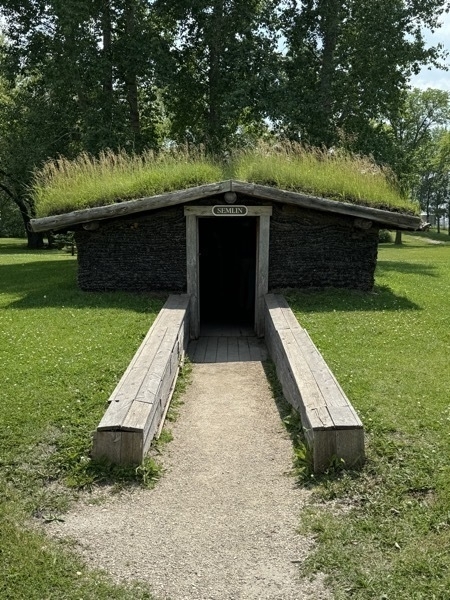
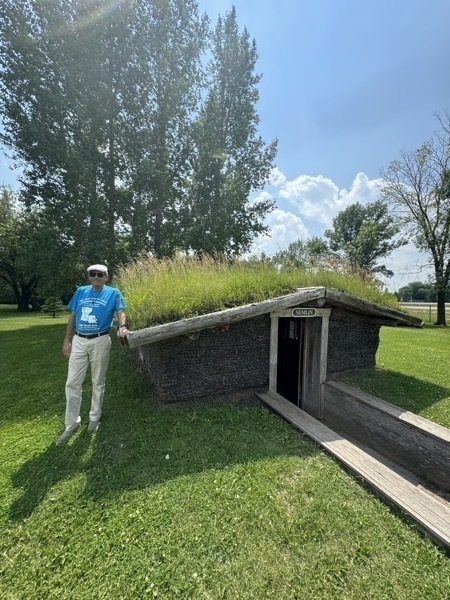
The house looks short on the outside but at least three feet of the base is underground. Once we walked down inside we saw that the inside ceilings were at least 8 feet tall.
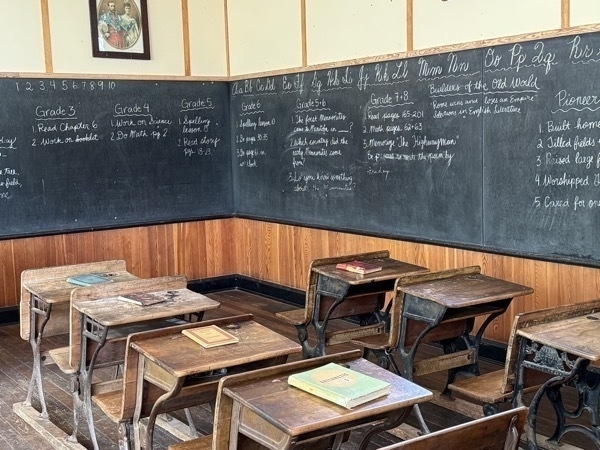
One room classroom with all student assignments on the board.

There were props on a table by an old fashioned background screen. The rolling pin just jumped into my hand.
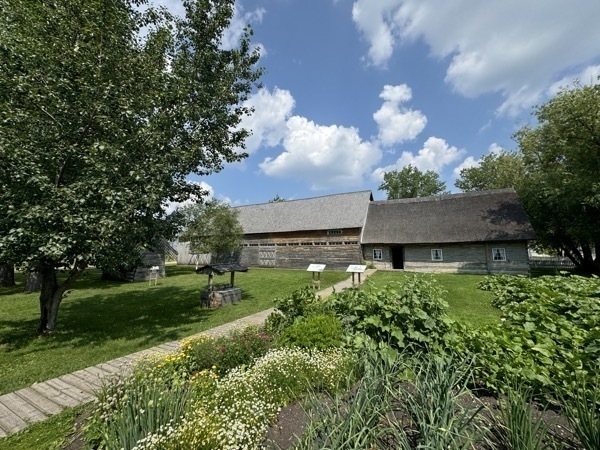

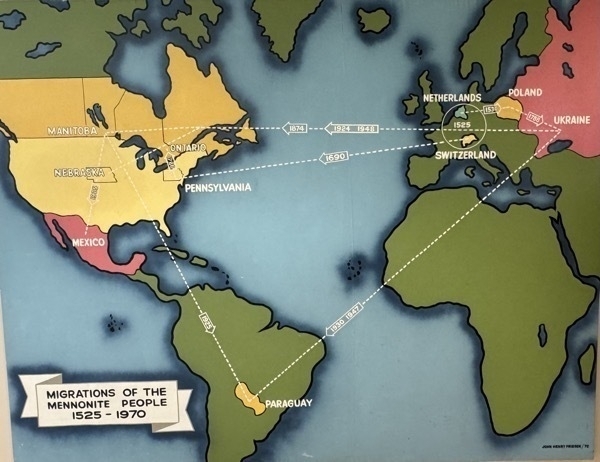
In was interesting to see that Mennonites originated in Amsterdam and Switzerland . The ones from Switzerland went directly to Pennsylvania in 1690 for religious freedom. The ones from the Netherlands went to Poland in 1530, to Ukraine in 1776 and then came to Manitoba in 1874, 1924, and 1948
The drive across the province
The ride from International Falls to Winnipeg was completely flat! We only went over one overpass the whole way. This road is straighter and flatter for a longer period of time that any other road I’ve ever traveled.


There were many large fields of canola flowers blooming all along the way.


TRIP STATISTICS:
- Miles driven in RV from last stop: 266
- Miles driven car today: 2
- Total miles driven in car and RV: 2,370
- Winnipeg West KOA Campground $43.91
- Groceries and food: $328.05 for an average of $25.23 per day
- Last was was $3.14 a gallon and we filled up the car and RV for $232.58, and average of $17.89 per day
subscribe via RSS